
Trout Switch and Spey Shootout
17 Two-Handed Rods Reviewed
by James Anderson and the Yellowstone Angler
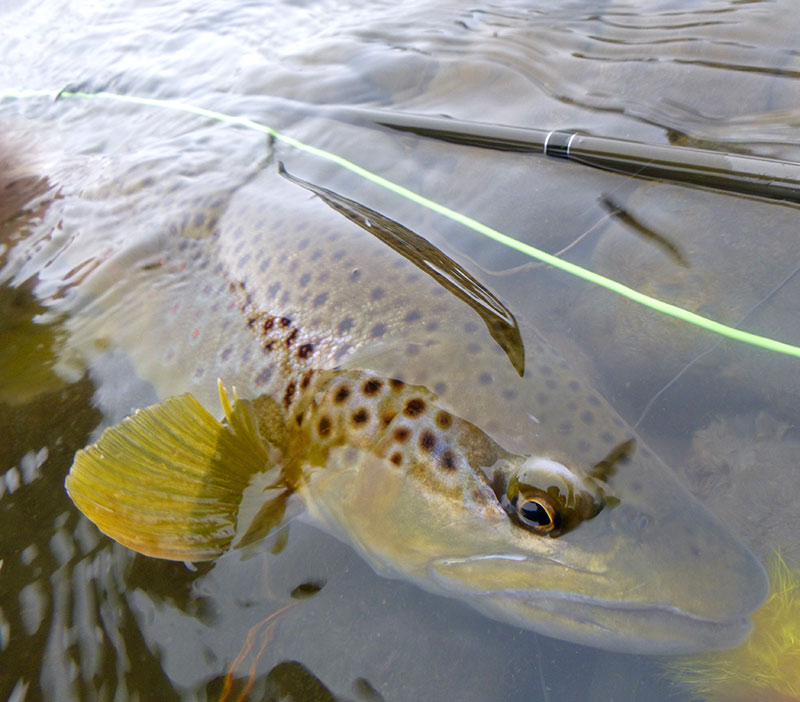
The new G.Loomis IMX Pro in use on the Yellowstone.
Learning to Use Two-Handed Rods
After having fly fished with a single-handed for years, learning how to cast and fish with a two-handed rod is like skiing your whole life, but then deciding to take up snow boarding. You are still on the river, and the basic principles of casting still apply, but in the end, you have a lot to learn, or “re-learn” if you will. It can be intimidating and almost cult-like when you hear spey jargon for the first time like: skagit lines, scandi lines, double-spey, snap t, blown anchors, perry pokes, and other unfamiliar nomenclature.
Learning to spey cast can be fun or frustrating, depending on the rod and line you start with. We feel learning to spey cast with a trout spey rod is less intimidating as they are much lighter (and shorter) than regular spey rods. In our opinion, the best line to learn with is a Skagit Scout, matched with one of Airflo’s 10′ FLOtips, followed by a short, 4′ leader – all of which you can read about below.
Instead of trying to explain the basics of spey casting here, we highly recommend you begin your learning process by purchasing one of Tom Larimer’s Skagit Revolution instructional DVD’s. Tom has been teaching anglers to spey cast for over 20 years now, and in my opinion, he is arguably the best instructor out there when it comes to explaining technique. If you want to your learning curve to be as steep as possible, buying this DVD is a no-brainer.

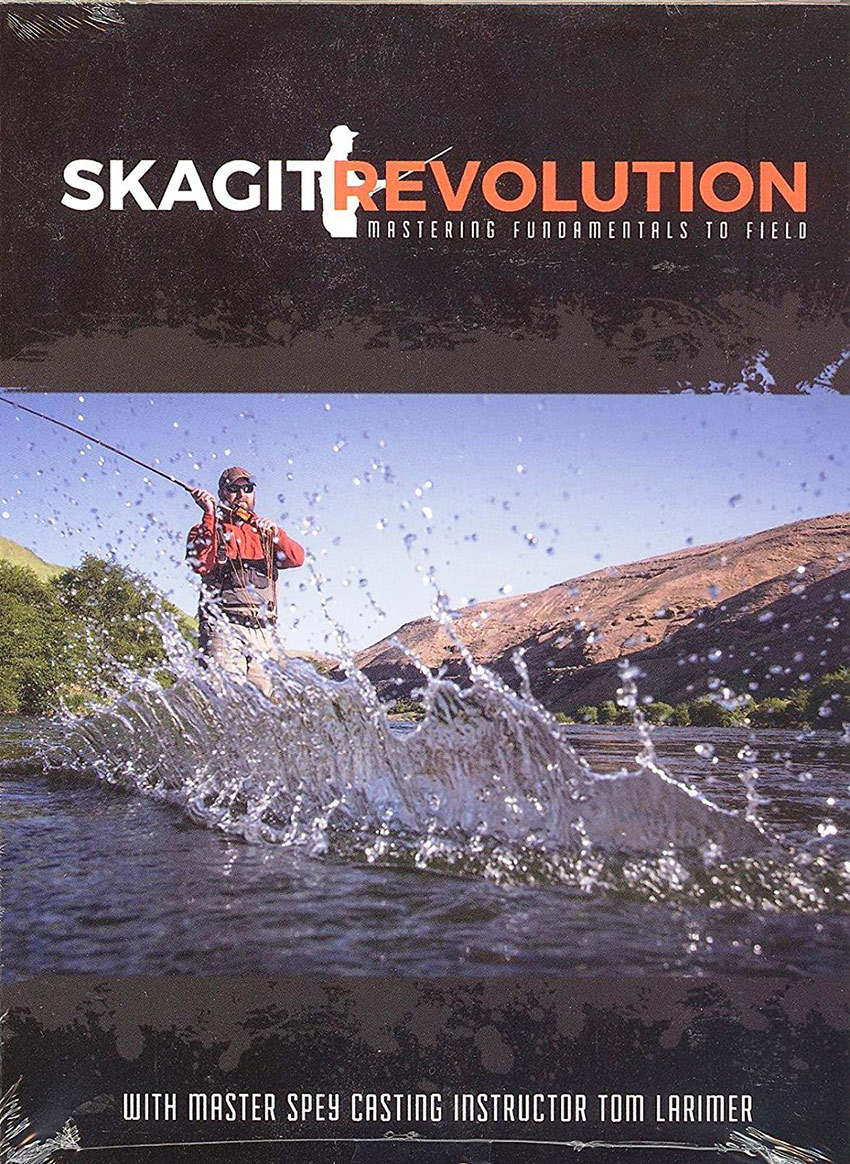
What are Trout Switch and Trout Spey Rods?
Trout switch and trout spey rods are simply smaller versions of “regular” switch and spey rods. These “micro” two-handed rods are lighter, thinner, and have softer actions than regular switch and spey rods, making them the perfect two-handed tool when nymphing or swinging for trout.
The Origin of Spey Rods
Spey rods are two-handed rods originally designed in the 1800’s for catching Atlantic salmon in Scotland. Originating on the banks of the River Spey, the first spey rods were 22 feet long and made out of greenhart wood. While bamboo and fiberglass spey rods are making a comeback, most modern day spey rods are made out of graphite and range in length from 12-15 feet. These powerful rods enable anglers to cast large flies great distances with less effort than single hand rods. When casting two-handed rods “spey style,” anglers are able to avoid hitting any objects behind them by anchoring their backcast on the water, keeping the majority of the line in front of them.
It wasn’t until just recently that switch rods were invented, filling the gap between single handed rods and two handed rods. Switch rods quickly became favored for those nymph fishing for anadromous fish because they were more effective at throwing longer casts, mending, and turning over heavier indicator rigs with longer leaders, while still being short enough to strike quickly and powerfully.

A nice Yellowstone brown caught on the swing.
Trout switch -vs- Trout Spey?
The main differences between trout switch rods and trout spey rods are their length, action, and intended purpose. Trout switch rods are shorter, typically 10’6” – 11’ feet and are primarily designed for nymphing. These rods are designed much like 9-foot rods, with stiffer butt (and midsections) and softer tips. While trout switch rods are designed for nymph fishing, many anglers still choose to swing flies with them as well. I personally like fishing a trout switch rod out of the boat, fishing a couple nymphs and pinch of tungsten putty under an indicator. Later we’ll look at the advantages of using a trout switch rod to nymph with over a regular 9 or 10-foot rod, but the biggest to me is their ability to achieving the perfect drift.
Trout spey rods are longer in length, (typically 11’6”-12’6”) and are designed for “swinging flies” from the bank “spey style.” Unlike switch rods, (or most 9 foot rods), trout spey rods are designed with softer mid-sections, which make spey casting more effortless by allowing the rod to do the work. Used correctly, a trout spey rod will cast your line much further than you could ever cast a 9-foot rod while using less effort. They are also particularly useful while wade fishing in areas that don’t have much room for a back cast. In spots like this, with the proper spey cast, an angler can effectively throw 60-100 feet and beyond with ease.
In order to compare rods the 17 rods in our Shootout to one another, we divided them into two groups – trout spey rods, and trout switch rods. The nine longer rods,(11.5 – 12.5 feet), with more flexible mid-sections that are more suitable for spey casting and swinging flies, we categorized as trout spey rods. The eight rods that were shorter in length, (10.5 – 11.5 feet), with stiffer actions that are more suitable for nymph fishing we classified as trout switch rods.
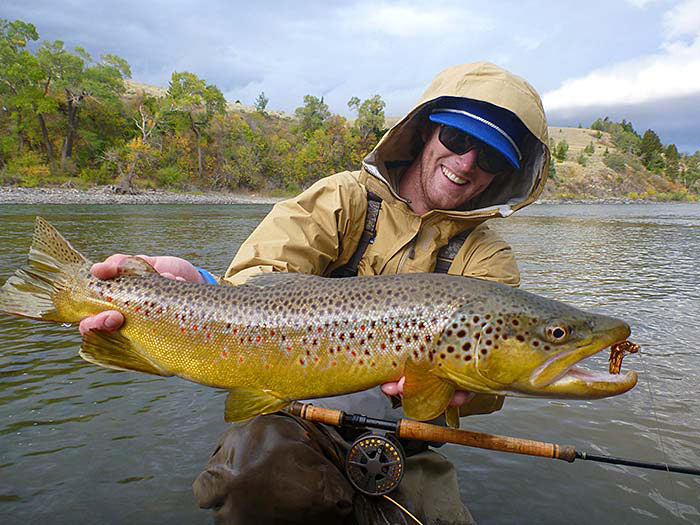
Paul Bloch with a nice Yellowstone buck caught on a Copper and Gold Kreelex
2017 5-Weight Trout Switch and Spey Summary
1. The Sage ONE Trout Spey takes top honors as the best trout spey rod to swing with at any price.
2. The Beulah Onyx, was another fantastic trout spey rod to swing with, nearly as long as the Sage ONE but with a slower action and softer feel to it. Those who appreciate a slower casting motion will love this amazingly smooth rod.
3. The G.Loomis IMX Pro Short Spey finished 3rd in our trout spey category, but is our economical winner for the best performing mid-priced rod. At nearly half the price of a Sage ONE, this is a terrific value.
4. The Orvis Clearwater is the best inexpensive trout spey rod, at $349.95
5. The Orvis Helios 2 was easily the lightest and most powerful switch rod in the Shootout, unfortunately this rod has since been discontinued.
6. The Douglas DXF placed second in our trout switch category, and is our economical winner for the best mid-priced trout switch rod. Now that the Orvis Helios 2 is no longer available, the DXF is the best trout switch rod on the market.
7. The Fenwick Aetos is the best performing inexpensive trout switch rod at $299.95.
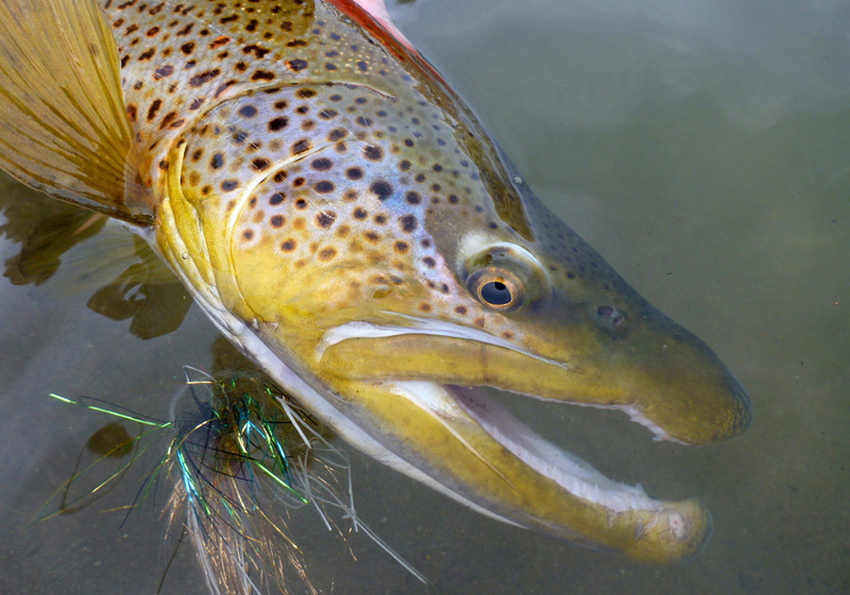
A winter Yellowstone brown caught on a two-handed rod… Photo: The Wizard
Trout Spey Rods









Trout Switch Rods








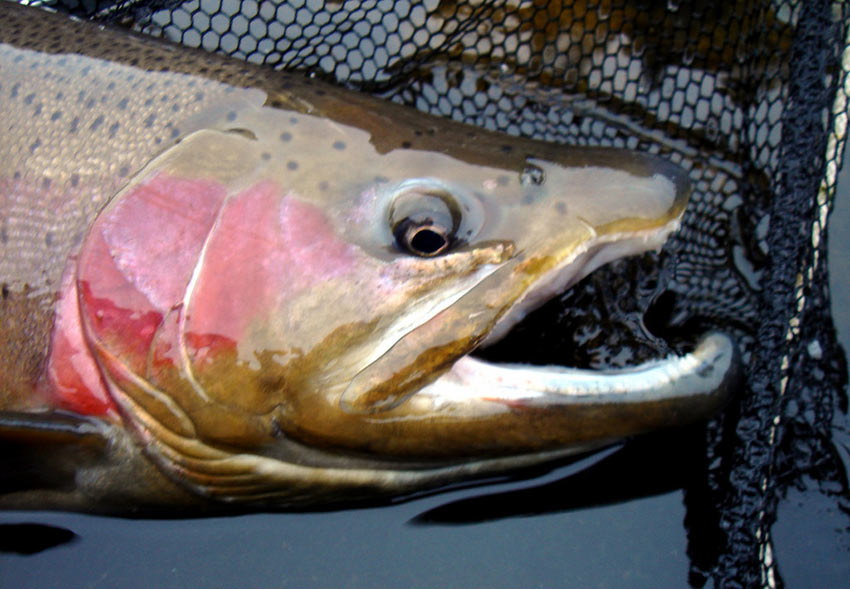
A fat Missouri rainbow.
But I Like to Swing with a Switch Rod and Nymph with a Spey Rod…
Don’t worry, you can still swing with a trout switch rod, (or a 9 foot rod for that matter), it’s just that a longer spey rod gives you a greater advantage when mending your line, manipulating your swing, and casting further. You can also nymph with a spey rod, which can be highly effective with practice, however longer/heavier rods are slower and more difficult to set the hook with once you see your indicator go down. Nymphing with a 12-15 foot spey rod from the bank is a form of art that is frankly too difficult to learn for many anglers. But for those who have mastered it and the line management involved, there is nothing more deadly in fly-fishing for achieving long, perfect, 100 foot drifts.
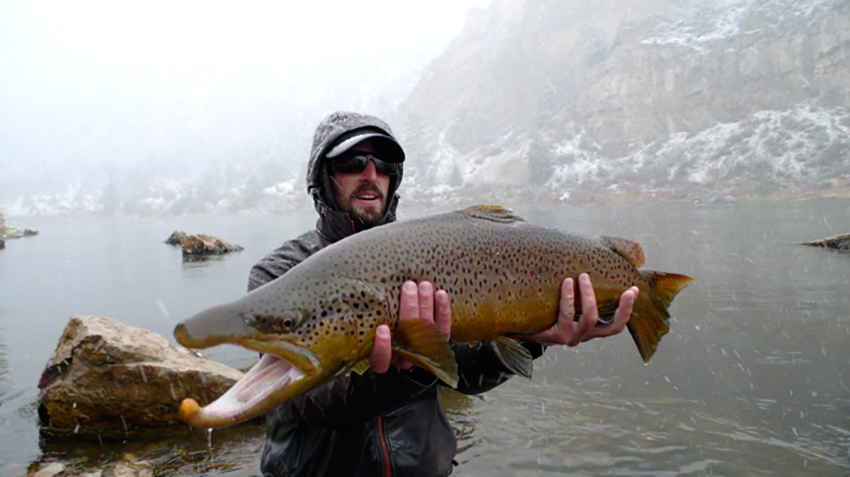
Eric Reithmiller knows the benefits of a two-handed rod over a single-handed rod… Photo: Eric Paulson
Why use a Trout Spey rod over a 9’ rod?
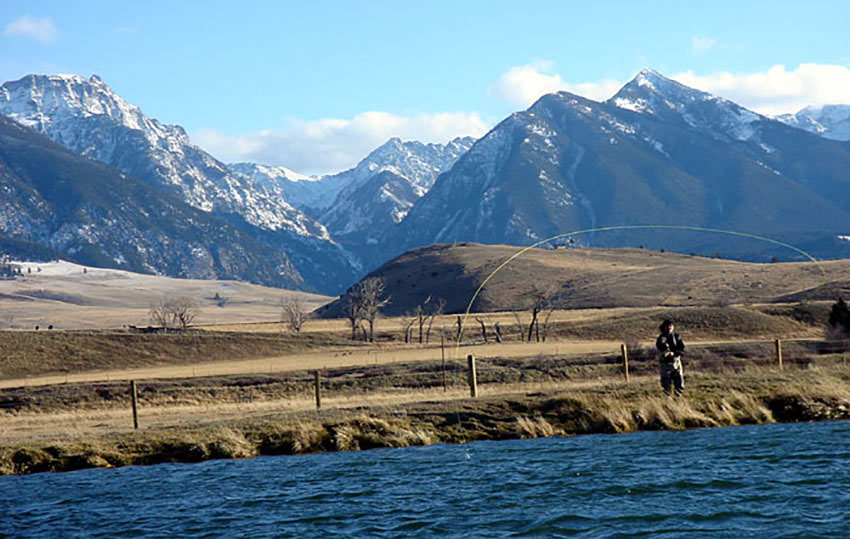
Windy Paradise Valley, the perfect place for a trout spey rod…
Why use a Trout Switch rod over a 9’ rod?
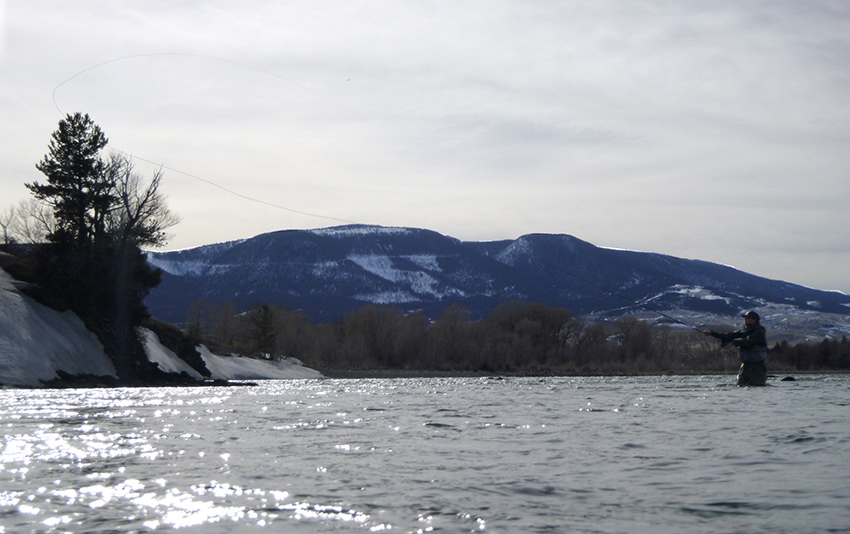
JG taking the Sage ONE Trout Spey out for a rip during testing. Photo: James Anderson
Keeping it Apples to Apples
As in prior shootouts, it is critical to eliminate as many variables as possible. We set up each of the rods we were comparing with the same exact reel, line, running line, amount of backing, and leader.
For reels, we choose our favorite trout spey reel, the TFO 375. Unfortunately Temple Fork Outfitters has now discontinued the TFO 375 and 450 reels! TFO if you are reading this, please bring this reel back! It is one of the single most underrated reels we’ve ever stocked.
For the trout spey rods, we chose our favorite trout spey line – Airflow’s Skagit Scout. We picked this line not only because it is shorter and better suited for most trout spey rods, but also because matched most of the rods perfectly.
For tips, we picked Airflow’s 10′ T10 FLO Tip. FLO tips have larger diameter butt sections, which we feel helps smooth the transition from your line to your leader while casting. With these lines, tips, and rods matched up with the trout spey rods in the shootout, learning how to use a two-handed rod has never been easier – and a lot of it has to do with how great these FLO Tips cast.
For leaders, we used two. On the trout spey rods, we used the shop’s hand tied trout spey leaders. Nothing fancy here, a perfection loop, 15 inches of 20 pound Maxima to a size 12 owner micro swivel, followed by 36 inches of Trout Hunter 1X fluorocarbon. For the trout switch rods, we used our hand tied trout switch leaders. These have stiff Maxima but sections, with a longer “knotless section” for ease of changing your indicator depth, and size 10 owner micro swivel, followed by 2 feet of Trout Hunter 3X fluorocarbon tippet.
For running line we picked the Scientific Angler’s floating braided polyethylene (PE) mono. It might not shoot quite as well as monofilament, but it shoots well enough and tangles a lot less. It floats and has very little memory, so it shoots well off the water. We also love the grip on it as you can really strip line well, which helps when stripping streamers in cold weather or when the fish runs right at you and you have to strip in quickly to keep it tight. Below we will discuss other running line options as well as provide some links on where to buy them.
Reels – TFO 375 – $374.95
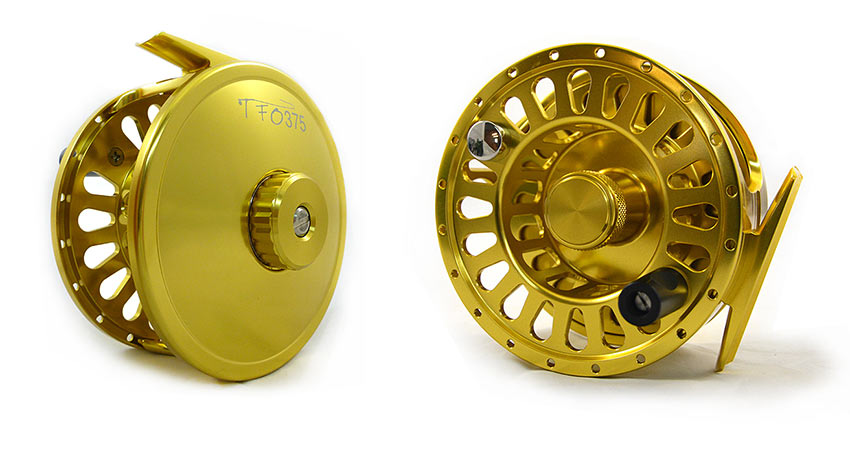
The TFO 375 has always been on of our all time favorite mid-priced reels, especially for trout switch and trout spey rods. For a 9’#8 weight, there are lighter reels on the market. For the longer trout switch and spey rods that have heavier swing weights, the TFO 375 helps balance the rod in your hand, eliminating more strain on your forearm muscles, especially when swinging.
One of the things I love about the TFO is that it spins like a skateboard wheel. The reel utilizes 3 sealed ball bearings that are amazingly smooth and allow the spool to spin better than any other fly reel I can think of. (If you can think of a better one please let me know!) In our 8-weight reel shootout, the TFO took top honors as far as “free spooling” reels go.
The TFO 375 is burly and durable to boot. I’ve fished these reels for nearly a decade now and trust their bulletproof nature. JG accidently dropped one and ran over part of it in his Dodge truck and it was fine. It is one of the toughest reels on the planet, (along with Abel, Tibor, and Nautilus), should you accidently take a digger and smash your reel into the rocks.
Luckily when we heard rumors of this reel going away, we called TFO and bought what they had left -about 20 reels. Since we love this reel so much we are not selling it on sale, and they will only be available when purchasing it an outfit. We still have a few red and gold reels left, but most of these are black. We hope TFO considers re-adding this reel back into their lineup.

The TFO reel put a quick stop to this Jurassic Lake rainbow, back in our 8-weight reel shootout.
Lines
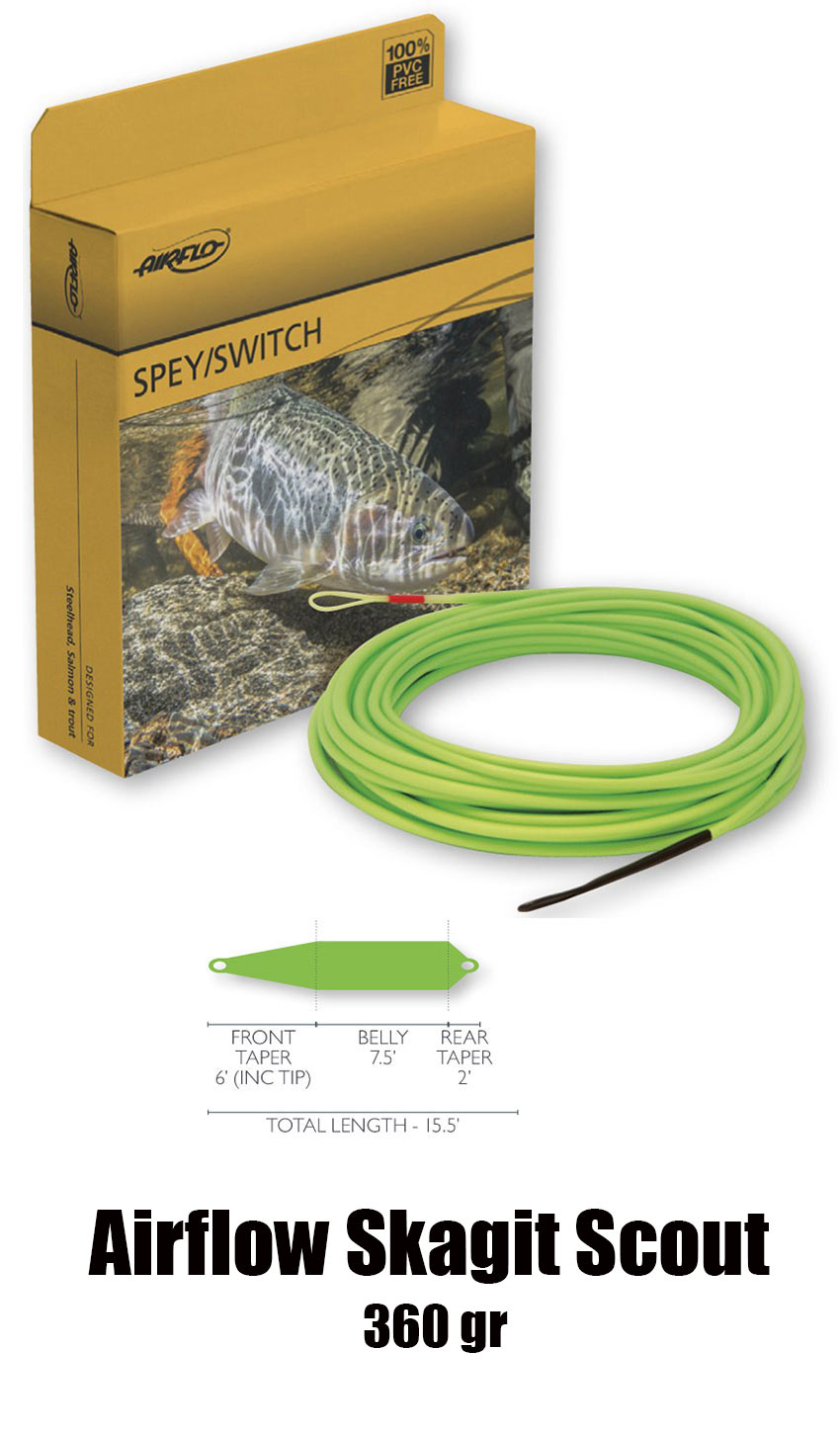
We chose the Airflow Skagit Scout 360 grain as the best all around swinging line for the trout spey rods. The Skagit Scout has a shorter head than most skagit lines, and works well with the shorter trout spey rods tested here in the shootout. The coatings on these lines are very good and we have yet to have any problems with them delaminating or separating over time. The wasabi green color is easy to see on the water, which makes adjusting your swing easy and fun. The Skagit Scout is now marketed on Airflow’s website as a line for either one-handed or two-hand spey rods.
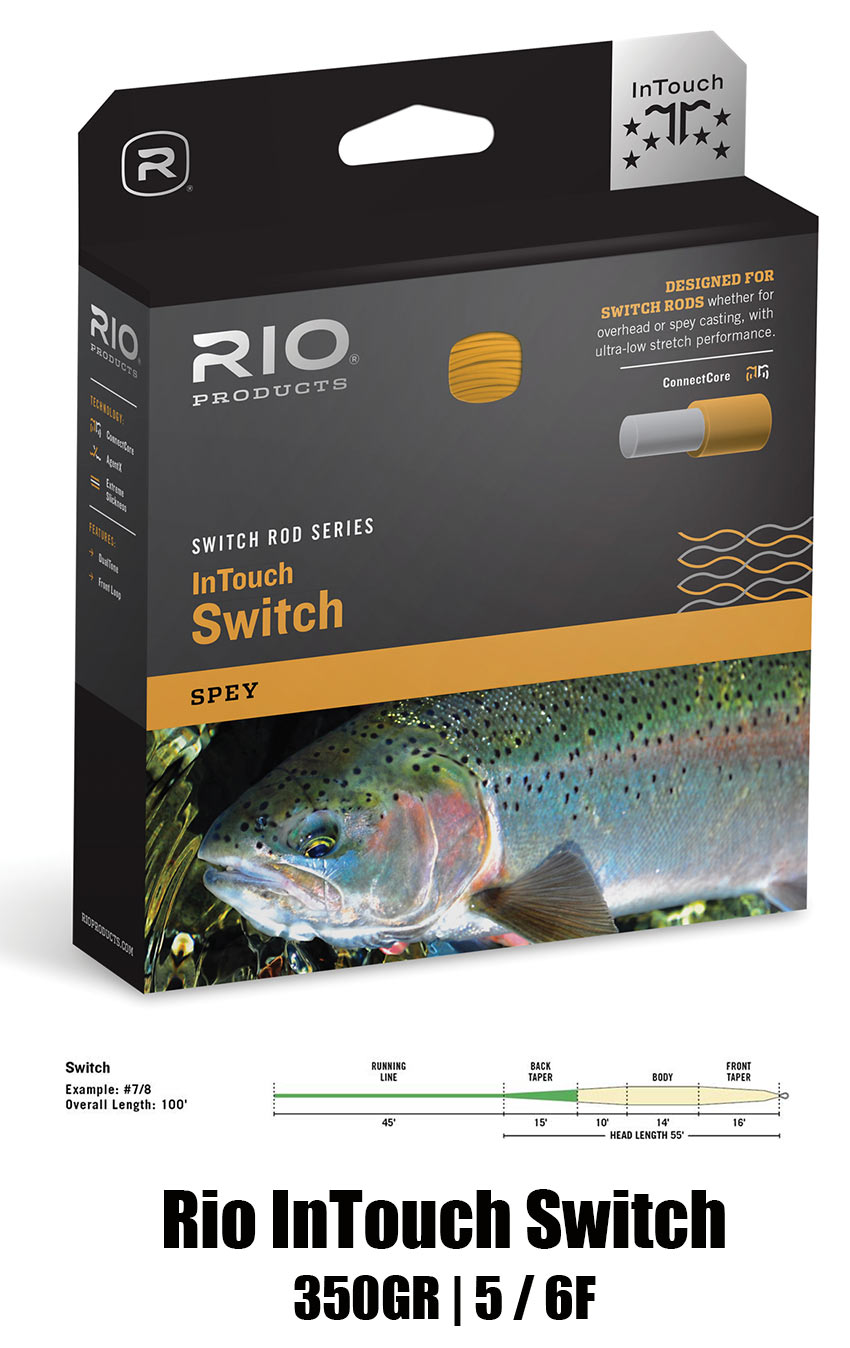
For the trout switch rods, we chose Rio’s InTouch Switch, which at the time of the test, was the only switch line available in a size WF-5-F. This line is 350 grains and has plenty taper to turn over a heavy indicatory rig, with a large indicator, weight, and two nymphs. Unlike the Skagit Scout that is designed for swinging, the InTouch Switch has a much longer belly as well as an integrated running line that is just thick enough to mend so you can achieve nearly a 100 foot drift! Like all switch lines, you do not need to add any running line between the backing and the line, nor do you need to add any tips – simply add a leader and you are ready to nymph.
Tips
Airflo FLO tip 10′ T10 – $26.99
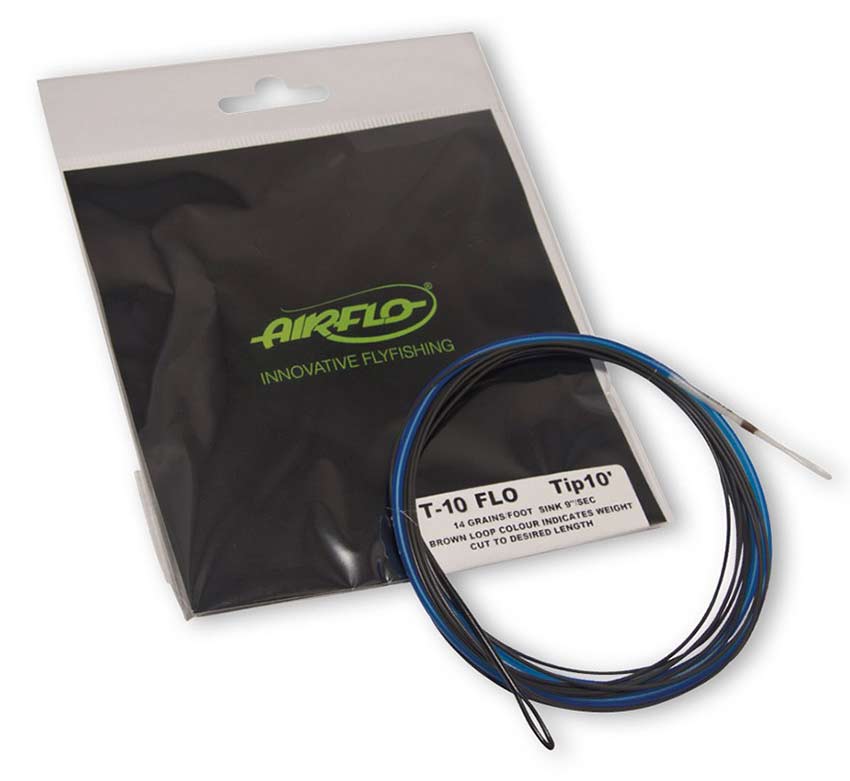
Our favorite tips for either spey or trout spey are Airflow’s FLO tips. For the 5-weight trout spey rods we choose the 10′ T10 FLO Tip. One reason we love FLO tips is that they have a larger diameter butt section, which allows for a smoother taper when transitioning from the line to tippet. FLO tips simply work better and “hinge” less than other tips. FLO tips only come in 10-foot lengths, but come in T7, T10, T14, T18, for $26.99 each or the entire kit (which includes a zippered wallet) for $120.99.
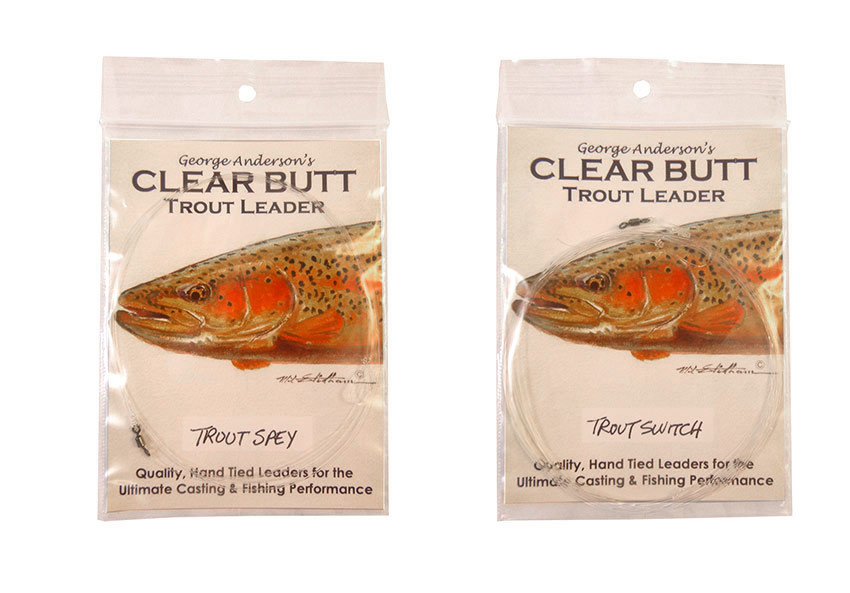
Both the trout spey and trout switch rods were tested with our own hand tied Yellowstone Angler leaders. On the trout spey rods, we used the shop’s hand tied trout spey leaders. These leaders come with a perfection loop so you can easily loop the leader into the thinner end of the FLO tip. Our Trout Spey leaders consist of 12-15 inches of 20 pound Maxima tied to a size 10 or 12 owner micro swivel, followed by 36 inches of Trout Hunter 1X fluorocarbon. With a longer tippet section like this you can change flies 4 or 5 times before having to re-tie some 1X to your swivel. We use a swivel over a tippet ring because it helps eliminate line twist, especially when stripping your fly back after you have completed your swing.
For the trout switch rods, we used our hand tied trout switch leaders, that are built for nymphing. These are composed of stiff Maxima but sections, a longer “knotless section” for ease of changing your indicator depth, a size 10 or 12 owner micro swivel, followed by 2 feet of Trout Hunter 3X fluorocarbon tippet. Having the ability to quickly change the depth your nymphs are being presented at is the key to catching more fish. If you are fishing a riffle you might have your indicator 2-3 feet above your weight or fly, but on a deep cliff hole, you might have 7 feet between your indicator and weight. We like the easy to adjust Air-Lock indicators for these leaders.
Running Lines
Scientific Anglers Floatig Braided PE (polyethylene) mono – $34.95
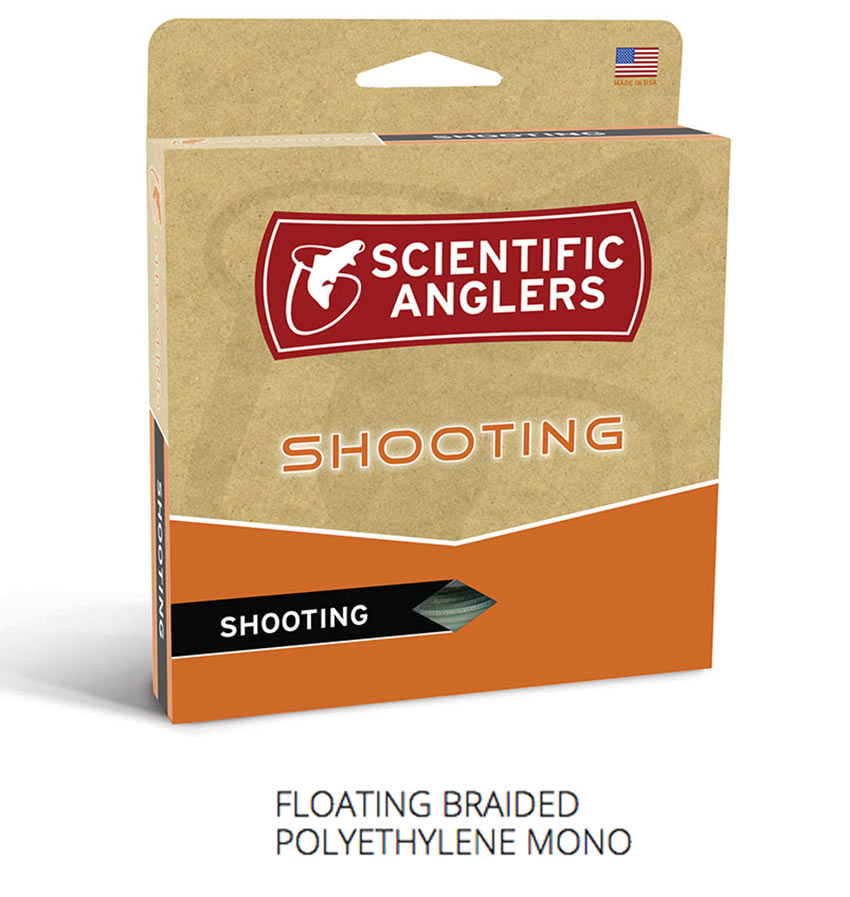
For running line we picked the Scientific Angler’s floating braided polyethylene (PE) mono. It might not shoot quite as well as monofilament, but it shoots well enough and tangles a lot less. It floats and has very little memory, so it shoots well off the water. We also love the grip on it as you can really strip line well, which helps when stripping streamers in cold weather or when the fish runs right at you and you have to strip in quickly to keep it tight. Below we will discuss other running line options as well as provide some links on where to buy them.
Choosing Your Own Favorite Running Line

When fly line coated running line does tangle it is usually a bad one!
When it comes to running line there are three main choices. Mono, braided PE, and fly line. To figure out your own favorite you should try them all. In the end, we decided on SA’s floating braided Polyethylene Mono (braided P.E. Mono) because it shoots pretty well, is somewhat more resistant to tangling, and has pretty good grip when it comes to stripping in line. We wish there was a running line out there that does not tangle, however we have yet to find one, no matter what material it is made out of!
If you are primarily targeting rainbow trout many people will go with straight mono as it shoots even further, and you often swing for rainbows without stripping your fly. If you are hoping to catch browns as well as rainbows, we’ve had good luck stripping the fly in the middle of the swing. Braided PE is much easier to handle than mono, especially when your hands are cold. Here is a quick explanation and breakdown of each style of running lines.
Mono Advantages: Shoots the best. Bright colors like fluorescent red or green have hi-visibility in the water. Mono is also easy to cut and re-tie together with a blood knot, if you have a bird’s nest or bad tangle. If you want to really go yard and send it to the other side of the river, this is going to be your best bet.
Mono Disadvantages: Has lots of memory (no matter what brand you buy despite the claims). Prone to tangles unless you stretch it well before every use. Can be frustrating for beginners when learning to clear your running line for longer casts. Not very easy to grip if you are stripping or retrieving your line. Not easy to grip in cold weather. Some monos float better than others.
Braided PE Advantages: Tangles less than mono but shoots better than coated running lines. Thicker and easier to grip when stripping your fly. If you get a tangle you can still cut it and re-tie it easily, although the blood knot will be larger than when tied with mono.
Braided PE Disadvantages: Won’t shoot nearly as well as mono. Overtime, when it becomes dirty it becomes more prone to tangles. Makes more noise than mono or fly line coated running lines. You must make your own loops and the knots are thicker than mono knots.
Fly line Coated Running line Advantages: Easy to grip and familiar feel. It also floats well when you have a pile of it stripped out at your feet. These come with welded loops for easy loop-to-loop connections.
Fly line Coated Running line Disadvantages: Won’t shoot nearly as far as mono or Braided PE. If it does tangle badly you can’t cut it and re-tie it out on the stream. Usually the only good alternative is to replace it.
Popular Brands and models of Running Line
Mono Running Lines
Berkley/Trilene Big Big Game Mono -$9.99
Braided Mono Running Lines
Scientific Anglers floating Braided PE 29 pound – $34.95
Airflo Miracle Braid 30 pound – $39.99
Fly Line Coated Running Lines
Rio Gripshooter (coated mono) – $49.99
Scientific Anglers Floating Dragon Tail -$59.95
Scientific Anglers Textered – $59.95
Scientific Anglers Monocore (coated mono) – $34.95
Airflo Extreme Running Line – $49.99
Airflow Super-DRI Running Line -$49.99
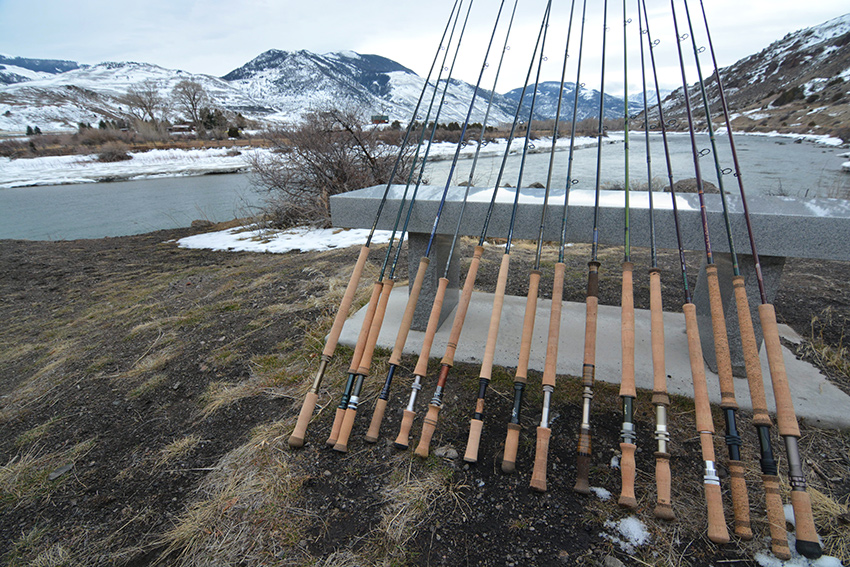
Choose your weapon…
Objective Observations
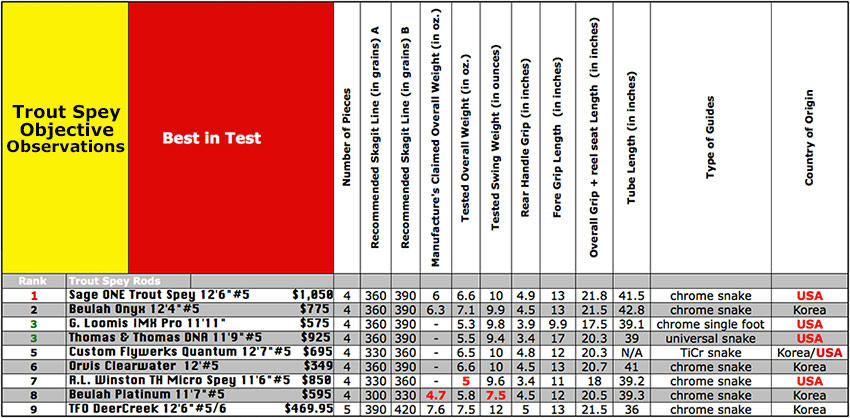
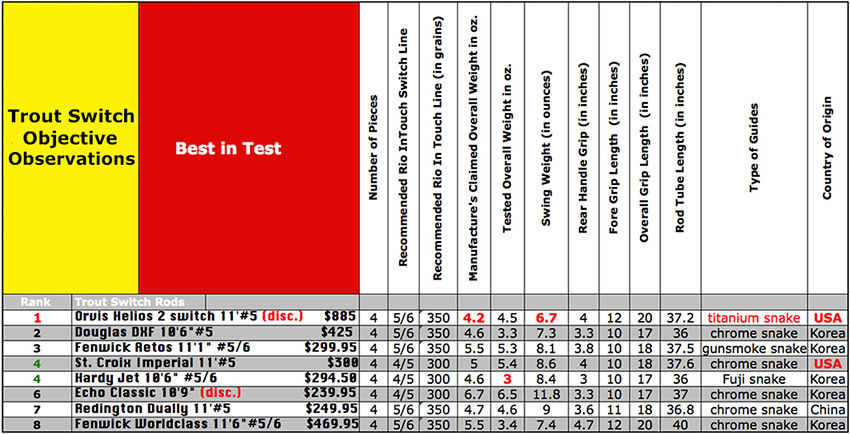
Objective Observation Columns Explained
Number of Pieces
All of the trout spey rods here are 4-pieces, except for the TFO DeerCreek is a 5-piece rod. In general I like rods that have an even number of sections, since it makes it more convenient to pull the rod apart in half and the upper and lower sections are equal in length. This makes it more convenient when putting in your car, a tight line rod holder, or an overhead rod box. It would be cool to see a manufacture make a packable 8-piece two-handed rod some day.
Recommended Skagit Line (in grains) A
In this column you’ll find our recommended grain weight for the Airflo Skagit Scout lines we used in the shootout. The “A” refers to advanced or expert spey casters who can already cast with proper technique and have already mastered the basic spey casts.
Recommended Skagit Line (in grains) B
In this column you’ll find our recommended grain weight for the Airflo Skagit Scout lines when used by novice anglers who are still learning to spey cast. In this case, the “B” refers to beginners who are still learning how to perform basic casts like the D loop, spey, snap T, and double spey. It is much easier to learn how to spey cast with a heavier line as you can feel the line load better. In other words, if you are just learning to spey cast, it will be less frustrating for you to start off with a line that is one line size up.
Recommended RioInTouch Switch Line
Here in the second table labeled Trout Switch Objective Observations, we give you our thoughts on which Rio InTouch Switch line best matches each rod. For most of the rods the 5/6 (350 grain line) was perfect. For the rods with softer actions we felt the 3/4 (300 grain) InTouch Switch lines were a better match.
Manufacture’s Claimed Overall Weight (in oz.)
In this column you’ll find the manufacturer’s published overall weight in ounces as per their website. Some companies did not post their rod’s overall weight, others did. Depending on the elevation and barometer, small differences in weight can be reflected.
Tested Overall Weight (in oz.)
Here is the data we collected in the shop on our trusty Brecknell postage scale. We measured all the rods on the same day in the same hour to ensure that we were keeping measurements as accurate as possible. After zeroing out the scale, we would put all 4, (or 5) sections on the scale and record the scale’s output in ounces, down to the nearest tenth of an ounce.
Tested Swing Weight (in ounces)
Swing weight refers to the amount of weight you feel out ahead of your hand when the rod is held in a horizontal position. The method in which we used to measured swing weight with the two-handed trout rods was basically the same way we measure 9-foot rods, the only difference being where we placed the fulcrum.
The fulcrum on single-handed rods is this balance point near the middle of the rod’s cork grip, wherever it felt most comfortable to grip the handle. We did the same with the two-handed rods, however we placed the fulcrum wherever it felt most comfortable to grab the foregrip of each trout switch or spey rod. Some of the foregrips were much longer than others, and in our opinion a little too long for getting the maximum amount of power out of the rod. Each angler is different, and will have their own grip preferences. Before measuring each two-handed trout rod, I would grab them with two hands and flex them back and forth a few times. Wherever I thought I could get the most power out of each rod is where I placed my upper hand on the cork grip, the fulcrum would then become the center of my upper hand’s position on the rod. Some rods, like the G.Loomis IMX Pro and Winston TH Micro Spey felt best when holding the foregrip right at the top. Others, like the Sage ONE, T&T DNA, and Beulah Onyx felt felt like I could get more power out of the rod by holding it an inch or two down from the top of the foregrip.
Next, I zeroed out our Brecknell scale (with a packing peanut already on it) and placed each rod’s fulcrum point on the foam pellet. I made sure that all the locking rings on the reel seat were spun all the way down to the bottom and then balanced the rod on the pellet by applying presure to the very end of the rear grip with my finger. As soon as the rod looked perfectly parallel to the floor, I would take a recording off the scale. I repeated this for each rod a half dozen times, zeroing out the scale each time. I took the average of these measurements and this figure became the swing weight. We have found that to obtain accurate measurements, all this must be done the same day, at the same temperature, and within a period of two hours or less. The swing weight is important, but with the two-handed rods it is not as precise a measurement than it is with one-handed rods.
Rear Handle Grip (in inches)
Rear handle grip length refers to how long the cork handle that sits below your reel seat. In the past we have seen some rear handle grips that were too short, and made trout spey rods feel too much like a toy than a real two-handed weapon. We are happy to that there are no tiny rear grip handles in this test. Preferences will change from one angler to the next but anywhere close to 4 inches feels about right.
Fore Handle Grip (in inches)
Fore grip handle length refers to the length of the cork handle above the reel seat. There are different opinions on how far you should grip your upper hand on the cork. Some will tell you it is better to place your hand as far away from the reel as possible, but I actually think you can produce more torque and power when you hand is closer to the reel. Either way, with a longer handle you can choose what feels comfortable for you. It is nice to have a little swell at the end of the fore handle grip. Rods like the Custom Flywerks nailed this while rods like the St. Croix Imperial have some work to do.
Overall Grip + reel seat Length (in inches)
Here is the total length from the top of the fore handle grip to the bottom of the rear handle grip, including the reel seat. I suppose these figures are not overly important but some anglers may want to know.
Tube Length (in inches)
In this column you’ll find the length of each company’s external rod tube. Many of these rods when measured in their cloth bag will be 1-2 inches shorter than the tube itself. We figure this would be good to know if you are planning on packing your rod tube in your luggage or a longer spey carry on, like the ones made by Fishpond.
Type of Guides
Here you’ll find the type of guides used on each rod. Keep in mind these are the guides on the upper portion of the rod. Most all the rods in the test use some type of ceramic lined SiC stripper guide as well. For more details on what type of stripper guide each rod uses, refer to the individual rod write ups.
Country of Origin
This column is straightforward. We like rods that are rolled, baked, and wrapped in the US the best. The Custom Flywerks rod was rolled and baked in Korea, but then the cork work and guides are wrapped here in the US.
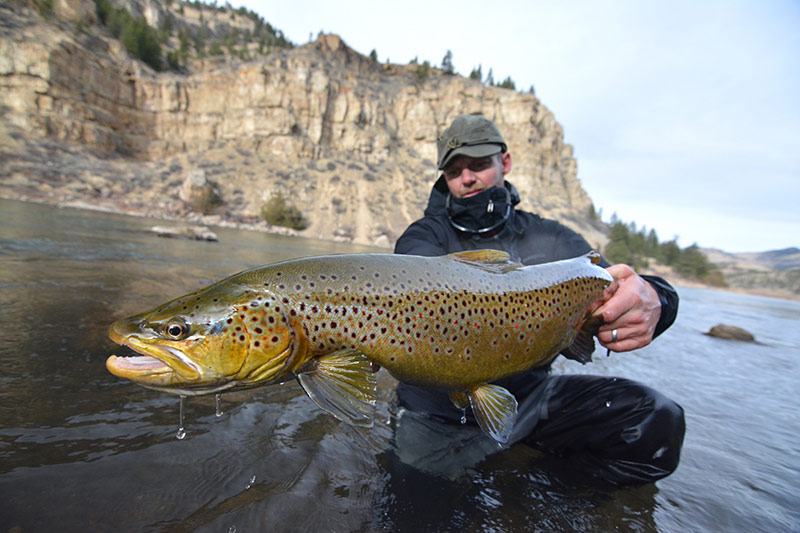
Hank Bechard with a big Montana brown…
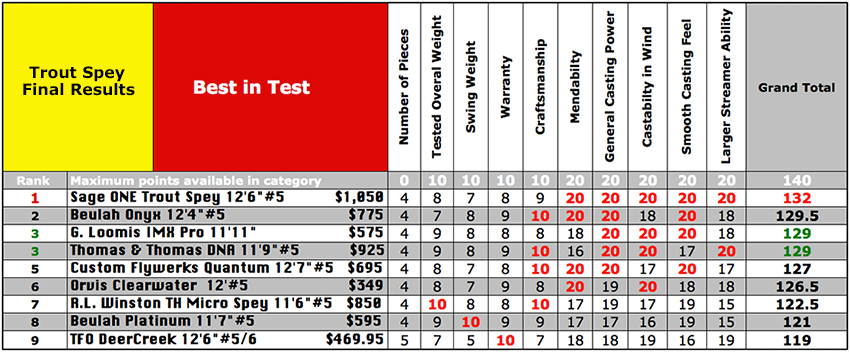
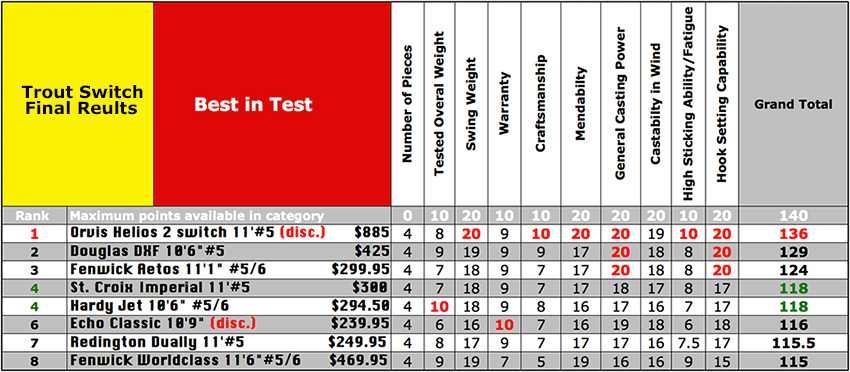
Explanation of points Categories
Number of Pieces – 0 points available
No points are award here, although I like 4 piece rods better than 5 piece rods.
Tested Overall Weight – 10 points available
The rods that were the lightest got the most points, the rods that were heavier scored less points. Here the Winston TH Micro spey was the winner.
Swing Weight – 10 and 20 points available
The rods with the lighter swing weights were awarded the highest points. For the swing rods we made this category a 10 point category because it did not feel as important as it did for the switch rods. Even when a trout spey rod had a heavier swing weight it still felt fun to cast, where as the heavily swing weighted trout switch rods simply did not feel as good to cast. The Beulah Platinum and Orvis H2 were the outright winners here.
Warranty – 10 points available
Every manufacturer now has some kind of “Lifetime Warranty”. Lifespans may be increasing, but Orvis’ is now merely 25 years. Nearly all are charging a “handling” fee of $50-$100 to repair or replace your rod. But then it is also going to cost you $15 or more to ship the rod in for repair or have your dealer do it. We looked at all the warranty policies in detail and updated those that have recently changed. Warranty policies with lower repair fees and faster turn around times were awarded the better scores. You will find each manufacturer’s policy listed below under Warranties Explained.
Craftsmanship – 10 points available
One thing that always impresses us is good craftsmanship. Thomas and Thomas and Custom Flywerks are in a class by themselves and really should have been award 11 points out of 10. Their wraps and coatings are simply perfect. Most companies are now using one-coat finishes, and these are difficult to apply without getting an excess of epoxy on the wraps. Multiple coats are much more time consuming but look far better. T&T and Custom Flywerks also have terrific cork grips. Some of the less expensive rods are using low quality cork and cheaper components.
Mendability – 20 points available
One of the great advantages of both trout spey and trout switch rods is their capability for mending line. Here longer rods are rewarded with greater points over shorter rods. Rods that were overly stiff with slower actions lost points too, where rods with more lively, energetic tips got awarded higher points.
General Casting Power – 20 points available
Here is where we start getting into the meat of the shootout – how much power do these rods have for casting under normal (non windy) conditions. For the trout spey rods distance was more important as you will want to be able to cover as much water as possible. For trout spey rods, a powerful butt and midsection is important to be able to throw enough weight and a heavy indicator rig, as well as have the power to set the hook well.
Trout spey rods that could easily throw the Skagit Scout, plus 50 feet of floating braided PE were awarded perfect scores. This roughly translates to about 100 feet of terminal tackle: 50 feet of running line + 33 feet of skagit line + 10 feet of FLO tip + 4 feet of leader = 97 feet. I was surprised how well some of the softer rods performed here when the wind wasn’t blowing, they were super smooth and effortless to cast once I slowed down and let the rod do the work.
Trout switch rods that could throw 50 feet of line + a switch leader + a large Thill indicator + a roll of tungsten putty + a size 8 rubber leg + by a size 12 bead head prince received perfect scores. Rods that struggled with this were knocked down accordingly.
Castability in Wind – 20 points available
If you live in Livingston or anywhere else where 20+ mph winds are par for the course, this category will be one of the most important. If you live somewhere calm and don’t really plan on battling with the wind when you are on a fishing trip then you might downgrade this category.
Smooth Casting Feel – 20 points available
(Trout spey only). This is a category we felt was more important for trout spey rods. Everyone enjoys a rod that can launch a long bomb, but if the rod is too stiff it can be less enjoyable when fishing normal to short distances, (often closer distances are where fish actually get caught since it is easier to control your swing more precisely). Rods like the Sage ONE, Beulah Onyx, IMX Pro, and Custom Fly works took top honors here. All of these rods are well designed and have that smooth, effortless casting feel to them.
Larger Streamer capability – 20 points available
(Trout spey only). If the purpose of your two-hander is to target large freestone brown trout, then this category is very important. If you are planning on fishing tail waters or plan to target rainbows and cutthroat primarily smaller streamers or soft hackles, then this category may not matter as much. In general, the rods that have more butt and midsection power do better here. If a rod easily could handle throwing a large articulated fly (such as one of Galloup’s Silk Kittens) 75 feet it got a perfect 20.
If you are really concerned with throwing larger streamers, then you may want to consider getting a regular 8-weight spey rod instead.
High Sticking Ability / Fatigue – 10 points available
(Trout switch only). Here we take a look at how swing weight directly effects your fishing, especially when you are holding your rod up high (to hold your line over faster currents in hopes of getting a perfect drift). Longer, heavier rods here will quickly cause fatigue, which makes it harder to concentrate and keep fishing hard. Longer rods with less swing weight are the kings here, and were awarded the most points. Shorter rods, or rods with heavier swing weights were knocked down a notch accordingly.
Hook Setting Capability – 20 points available
(Trout switch only). The ability to firmly and quickly set the hook when your indicator goes down is one of the major keys to nymph fishing success. Rods with more backbone in the butt and mid-section get high scores here, as they have the power required to really drive the hook into the fish’s mouth. The longer the rod is, the harder and more awkward it is to set the hook, so longer rods loose points in this category, as do shorter rods that lack enough power to strike well. This is one reason we put the Beulah Platinum with the rest of the trout spey rods, as it simply is too soft to make for a good nymph fishing tool.
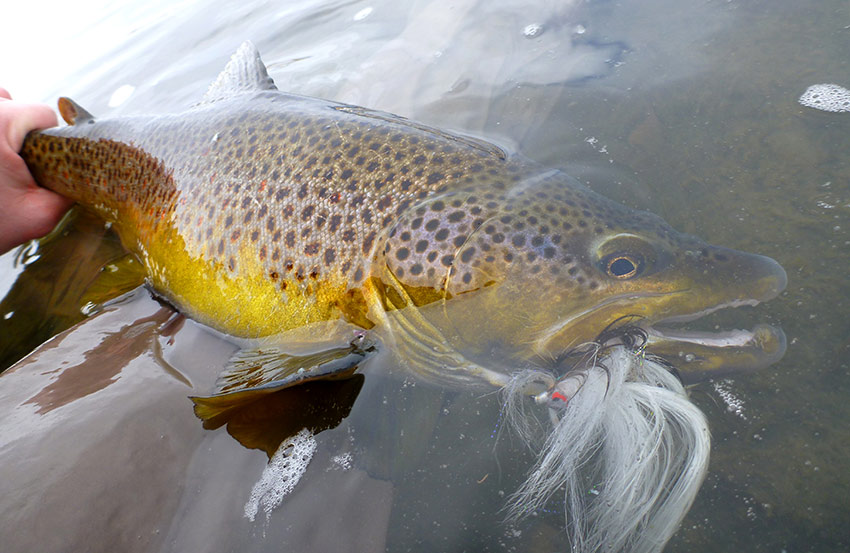
Another Yellowstone brown caught on the swing – this one fell for a white Home Invader
Warranties Explained; Manufacturer by Manufacturer
Here is a short recap of each manufacturer’s policy and what we have experienced for repair time required.
Beulah – Original owner lifetime warranty for defects. Must be registered within 30 days. Breakage from misuse or negligence will be repaired at reasonable cost. $50 handling fee. Usually takes 2 weeks.
Douglas – Lifetime warranty. $35 handling fee. Rods are repaired, not replaced. Usually takes one to two weeks.
Echo – Lifetime warranty for original owner. $35 handling fee. Rods are replaced. Usual time 2-4 weeks
Fenwick- Lifetime warranty. $35 handling fee. Rods are replaced. Usual time 2-4 weeks.
Hardy – Lifetime warranty to original owner. $35 handling fee, plus $75 for each broken section. Rods are repaired. Shipping is from their US warehouse, usually about 10 -14 days.
G. Loomis – Lifetime warranty to original owner. You send in rod and their warranty dept. examines it. If rod is broken because of a defect, or while fishing, replacement is free. No handling fee. If from neglect or any other cause, you must use the Expeditor service, which charges your credit card $100 but you get a brand new rod in 3-4 days. AK or HI shipping add another $25.
Orvis – 25 year warranty to original owner. $60 handling fee. Rod is repaired, not replaced. Usually takes 2-4 weeks.
R.L. Winston – Lifetime warranty to original owner, $50 handling fee. Older rods not under warranty cost $120 or more. Rods are repaired, not replaced. Usually takes 4-6 weeks. Winston does offer a “lender” program while your rod is being repaired but this is still somewhat of a hassle.
Sage – Lifetime warranty to original owner. $75 handling fee. Rods are repaired, not replaced. Usually takes 4-6.
St. Croix – Lifetime warranty to original owner, $85 handling fee. Rods are repaired, not replaced. Usually takes 2-4 weeks.
Temple Fork Outfitters (TFO) – Lifetime warranty to original owner. $35 handling fee. Rods are either replaced with a new rod or the broken section is replaced. Usually takes 1-2 weeks.
Thomas and Thomas – $55 repair charges for the original owner, includes shipping. Non-original owner $150 per section. You must register the new rod within 30 days.
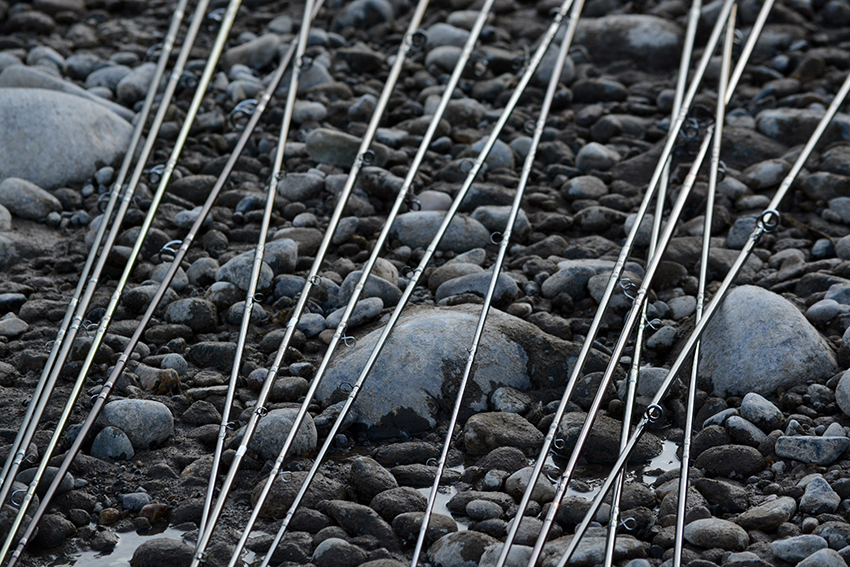

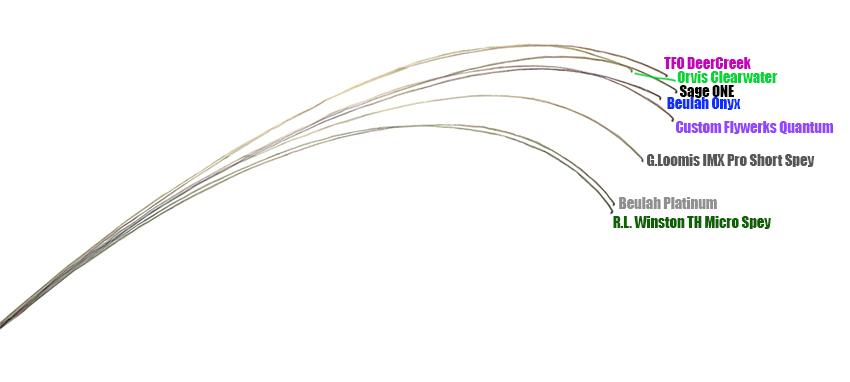
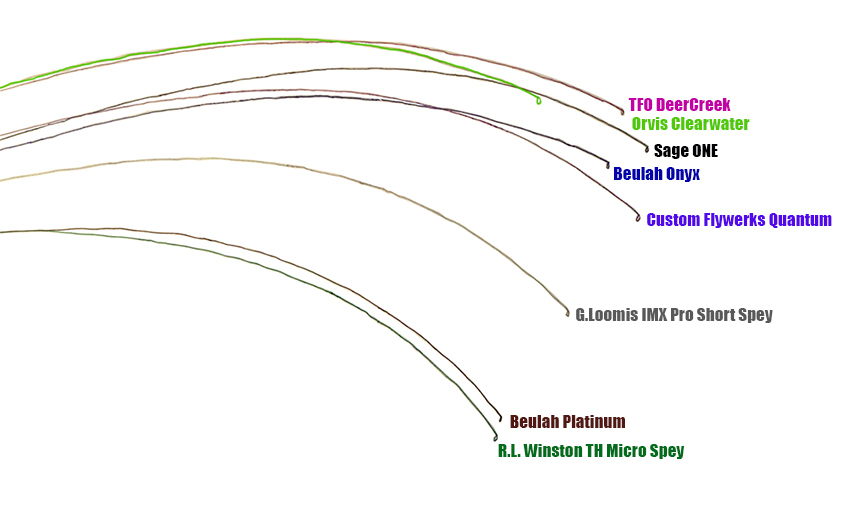
Our deflection charts have been popular in our single handed rod Shootouts, so we wanted to include them with this Trout Switch and Spey Shootout. Our apologies, we had to send many of the trout switch rods back to the manufacturers before we had a chance to deflect them, so above you can only see how the trout spey rods deflected. As you can see there is a lot more variation than deflecting 9’#5 weights, which were all pretty similar. Keep in mind it is more difficult to compare how these rods bend to another since they are different lengths. Still, you can see which rods were stiffer and which were softer, which translated to how they performed on the water.
In making the deflection charts, we placed the rods at approximately a 45-degree angle and then hang a lead weight of 3.9 oz. from the tip top, (this is the same amount we used for right for the 9′ 5 weight rods). In hindsight we probably should have used a 6.2 ounce weight, (which is what we used for the 9′ 8 weight rods), as it would have shown a deeper bend and it would be easier to see which rods were faster (bent down more) and slower (little bend in the tip).

James Anderson with a Yellowstone brown caught on the swing. Photo: Paul Bloch

(for Trout Switch Final Results please scroll down)
Trout Spey Rods – For Swinging Flies
1. Sage ONE Trout Spey 12’6” 5-weight $1050.00
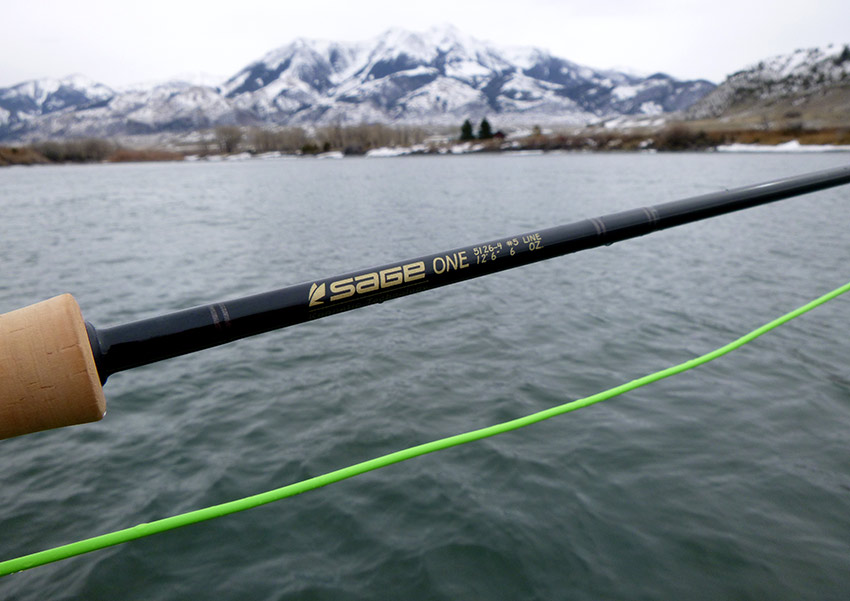

The Sage ONE Trout Spey 12’6” 5-weight is unbelievably light for its length, but most of all I like how much power this rod has over other trout spey rods. This long, light, and powerful combination make it the ultimate trout spey weapon for swinging flies, especially in Livingston where a 30 mph winter wind is just par for the course. We tested this rod (and the others) with a size #6 Sculpzilla, but after seeing how much power it had we also tried it with larger flies, such as size #2 Home Invaders, #4 Sex Dungeons, and other articulated streamers that big browns like on the Yellowstone. Softer trout spey rods had more difficulty handling these larger streamers, where the ONE handled them like a champ.
The Sage ONE Trout Spey blanks are finished in a jet-black color with matching black wraps over Fuji ceramic stripper guides and chrome snake guides. All of the guides including the tip-top are the perfect size for trout spey. The quality of cork is very good, although the length of the foregrip seems longer than it needs to be. The aluminum down-lock reel seat isn’t fancy but functions perfectly with two well-gnarled locking rings to keep your reel secured tightly. A powder coated aluminum rod tube and cloth bag are included.
Our only gripes – like other Sage rods, the epoxy work on the snake guides is a little thick and sloppy for a thousand plus dollar rod. Also the only disadvantage to the Sage ONE Trout Spey’s extremely lightweight feel is that they may be less durable than some of the other rods.
Casting Notes:
Light, powerful, and effortless to cast. Capable of throwing very tight loops, this rod punches into a headwind with ease. I love how this rod does the work for you and throws long bombs with minimal effort. The 12’6” length really helps throw a big mend to get your fly deeper. It’s also amazingly light so you can high stick this rod without much shoulder fatigue. This rod is very sensitive which means there is little question of whether you had a bite or bumped some rocks.
Any serious steelheader would be very happy with this rod while fishing in trout territory.
2. Beulah Onyx 12’4” 5-weight $775.00


The Beulah Onyx is a terrific rod, matched in both performance and style. This rod’s fancy reel seat and cork detailing are as appealing as the Onyx’s smooth and effortless casting action. If you want a great trout spey rod for swinging, but don’t prefer a super fast action, the Onyx is the perfect choice.
The Beulah Onyx series blanks are finished in a dark smoke blue with blue wraps over ceramic stripper guides and chrome snake guides. No alignment dots are used. Accent trim wraps just above the cork and on each ferrule bring a little pop to this rods appearance. The reel seat is one of the very best in the test. The up-lock style locking rings are exceptionally smooth and easy to spin along the threads. I particularly like the colorful, burled maple insert. The Portuguese cork is excellent quality with attractive cork burl accents. I like the shape of both the foregrip and rear grip handles. A cordura coverd rod tube and cloth bag are included.
The Beulah Onyx is one sweet rod. For those who aren’t looking to rush or punch their cast and would rather take it easy with a nice smooth casting storke, while still throwing long casts, this is your rod.
Casting Notes:
Nice and light in hand, although the Sage ONE, G. Loomis IMX PRO, T&T, Winston Micro Spey, and Beulah Platinum feel lighter. More of a medium action, you have to remember to take your time with the Onyx rather than rush it, otherwise you will likely blow your anchor or struggle to power through it. Correct timing and power application make this rod delightful to cast. Fishing this rod is fun and it’s forgiving, although not nearly as poweful casting into the wind as the Sage ONE, G. Loomis IMX PRO, T&T DNA or Orvis Clearwater.
3. (tie) G. Loomis IMX PRO 11’11” 5-weight $575.00


At nearly half the price of the Sage ONE trout spey, and $200 less than the Beulah Onyx, the IMX PRO is the most economical winner of our Shootout. This is a rod that provides superior performance at a mid-price level. Tom Larimer and Steve Rajeff did a terrific job teaming up to design these rods. They spent their due diligence in terms of whittling them down to perfection after several rounds of designing, testing, and fishing. The results were worth their extra effort, and now anglers who are interested in getting into trout spey will appreciate this powerful, durable, and affordable rod.
The IMX PRO trout spey rods are built for swinging flies. As such they have softer mid sections, which allow the rod to load easily and “fling” your line effortlessly. The Scout 360 skagit line with an airflow T-10 FLO tip matches the 11’11” 5-weight like a tailored suit and buying them in combination really sets a novice spey angler up for success.
The IMX PRO blanks are finished in graphite grey with matching grey wraps over ceramic stripper guides and chrome single foot guides. The cork quality is excellent and the shape of the foregrip and rear handle grip are the perfect length for trout spey. The aluminum down-lock reel seat isn’t fancy but functions well. A thicker lock ring followed by a thinner lock ring are utilized to keep your reel secured tightly. A hard tube and cloth bag are included.
If you can afford to throw down $1000 on a trout spey rod treat yourself to a Sage ONE, otherwise go with the G. Loomis IMX PRO, which is nearly half the price, with nearly the same level of performance. This is one smart rod, and one smart buy.
Casting Notes:
Although the IMX PRO isn’t the longest rod here, it can cast just as far as any of them. It’s a powerful rod and was one of the better rods for punching into a steady headwind. I felt like this rod had a wide sweet spot as well, as I could “save” the cast with a little more power if I didn’t have my timing perfect. When my timing was perfect I was blown away by how far I could cast. Line management easily became the most important factor between making a 100 foot cast or a 150 foot cast.
3. (tie) Thomas & Thomas DNA 11’9” 5-weight $925.00
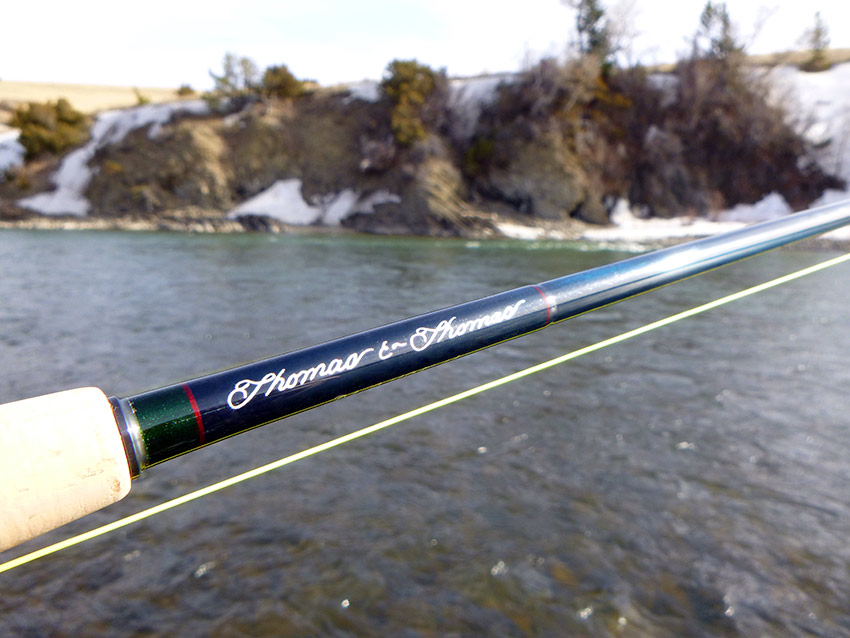

Here is your powerhouse of the shootout. The T&T DNA is lightweight, and explosive. When it comes to punching spey casts into a 30+ mph wind all day, it is easily king of the river. Although this rod is not as long as others, it has no problem casting equally as far, if not the farthest.
Anglers who prefer a slower action might want to stay away from a rod this stiff and aggressive. But for anglers who often fish in windy areas, the T&T DNA is one of the best rods on the market. It would also be a good choice for fishing heavy sink tips like 10 feet of T18 to dredge the deeper, slower runs in the winter. Fish it with confidence and be proud of it’s spectacular craftsmanship.
The T&T DNA blanks are finished in a handsome deep blue with emerald green wraps and red trim over Fuji stripping guides and Universal snake guides. Like Winston, T&T writes the serial number on each section of the rod which also serve as alignment dots. The cork quality is impeccable and the shape of the grip is different from others, more of a cigar taper than an upward swell at the forward end, which looks different but classy. The pewter grey milled aluminum down-lock reel seat works well and looks elegant with the added Thomas and Thomas engraving. A hard tube and cloth bag are included.
An additional bonus – when we originally tested the T&T DNA 11’9″#5 it was $1,055.00, but now the price has dropped $130.00 down to $925.00!
Casting Notes:
Wow. This rod has a TON of power. Easily the long bomb king, and the best rod here when punching into the wind, despite its shorter length. The DNA feels insanely light too – only the Beulah Platinum had a lighter swing weight. If only this rod were a little longer, it would make mending and high sticking a little easier. I would like to see a 12′ or 12’6″#5 TNT DNA that is equally light and powerful – that would be the ulitmate windy day weapon for swinging flies to big trout.
4. Custom Flywerks Quantum 12’7” 5-weight $695.00
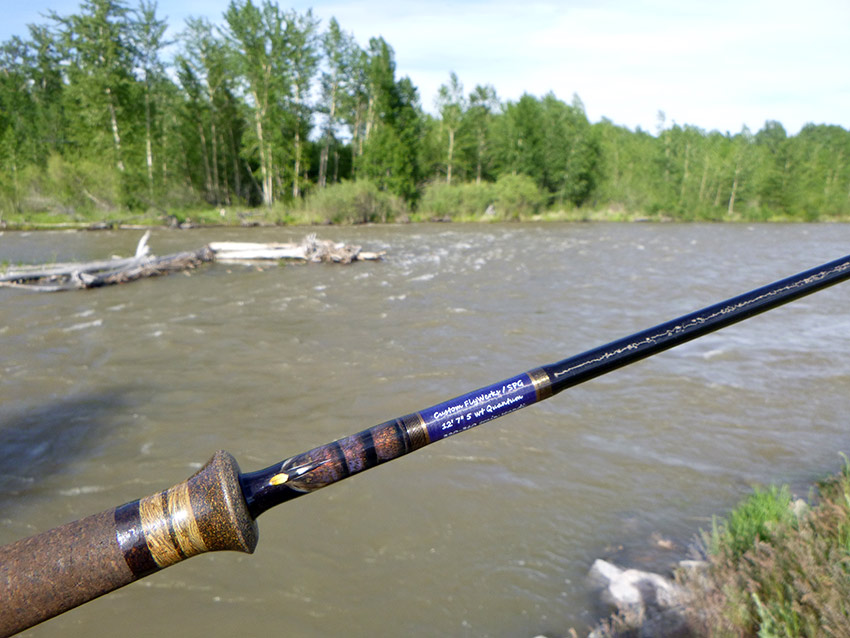

Here is a fantastic trout spey rod designed by Steve Godshell. If you are familiar with Bob Meiser’s spey rods, then you may recognize the distinct and amazing work that Steve does coming out of the same shop. Steve’s reputation as master rod designer and line wizard are not only warranted but underestimated. Words like master, guru, and genius all come to mind when thinking of Steve and his work.
Custom Flywerks rods are all built on mandrels designed by Steve, but with the impeccable quality and workmanship you’d find in a Meiser rod. In our opinion these rods should really cost over $1,000.00. You may want to buy one soon, since eventually the laws of supply and demand will work themselves out, and these will cost more than a grand! (And they should)…
The Quantum 12’7” 5-weight is the longest rod in the shootout, yet you’d never guess that by picking it up. Comparatively, it feels exeptionally light and well balanced. Similar in action to the Beulah Onyx, the Custom Flywerks Quantum is more of a medium action than a fast/stiff action, which stays true to many of Steve’s rods. As such, it is delightful and effortless to cast, although not as powerful as the Sage ONE, T&T DNA, or G.Loomis IMX PRO. Mending is a breeze with this rod, and high sticking it into your swing is delighful.
The Custom Flywerks Quantum blanks are finished in a gray graphite color with matching gray thread wraps over carbide ring TiCr strippers and TiCr snake guides. With a similar look to Scott’s blanks, the tape marks remain unsanded. The end of each section has an interesting “checkered” carbon fiber weave that I’m not used to seeing on other blanks. One of the amazing things about the Custom Flywerks rods (something you’ll also find on Meiser’s rods) are the colorful feather inlays located just above the cork handle. You can choose from a variety of feathers, but my favorite is the turkey feather with a single plume of jungle cock. In the sun, the turkey feathers turn brilliant and iridescent, and look a different color depending on the angle you hold the rod. The cork is also off the charts in terms of both quality and aesthetic beauty. Easily my favorite cork handle of all the rods, as the handles felt perfectly shaped. The down-lock Titanium Gunsmoke reel seat looks as fancy as it sounds, with two very smooth spinning lock rings. An aluminum rod tube and cloth bag are included.
Attention Sage – this is what a thousand+ dollar rod should look like!
Casting Notes:
Similar in feel and lightness to Beulah Onyx… Very light feel, I would never have guessed this was the longest rod in the test. This rod performs best when you slow down and let the rod do the work. When taking your time this rod is effortless to cast. If you are really trying to bomb it out there as far as possible or need to punch it into the wind, the Sage ONE, G. Loomis IMX PRO, or T&T DNA are going to have usuable more power. If you are fishing reasonable distances however, it will be hard to find a rod that feels as smoothly “zen” as the Quantum.
5. Orvis Clearwater 12’ 5-weight $349.00
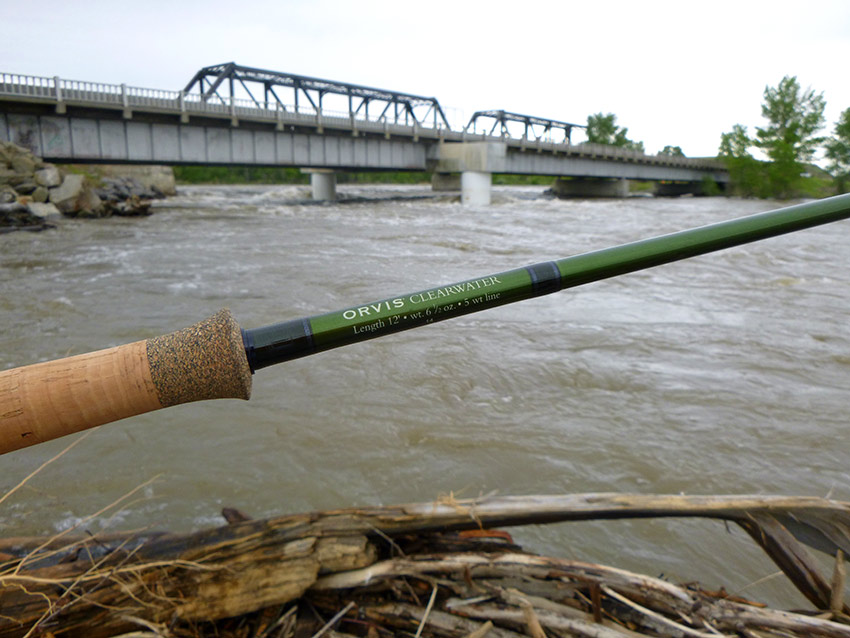

Here is our pick for the best inexpensive rod to swing with. It has a lot of power but also a wide sweet spot, which will be easy for beginners to hit. At 12 feet long, the Clearwater is long enough to make big mends and manipulate the line better than shorter trout spey rods. Purchasing this rod will give you a little extra allowance to pursue a nicer reel than you otherwise may not have considered.
The Clearwater is a terrific value for it’s level of performance, and easily the “best buy” in our Shootout.
The Orvis Clearwater in finished in an olive green color with dark olive wraps over Ceramic lined stripper guides and chrome snake guides. The snake guides are generously oversized, which will help clear running line tangles. Also oversized is the huge up-lock reel seat, with two enormous locking rings that tend to squeak over time. The reel seat and handle are huge, and look like they belong on a rod for king salmon rather than trout! Orvis uses a black and green carbon fiber inlay that matches the blank well. The cork is very good quality for the price and the shape of the upper and lower handles are very good. A cordura covered rod tube and cloth bag are included.
Casting Notes:
Impressive! The Clearwater is a two handed cannon that throws long like a champ. However, it is noticeably heavier than the Beulah Onyx, Sage ONE, Custom Flywerks Quantum, and G. Loomis IMX PRO. Once you do get this rod in motion it will really throw some line. Lighter and smoother than the TFO DeerCreek, this rod is a fine performer especially when you consider the price tag. Lots of bang for your buck here…
6. R.L. Winston TH Micro Spey 11’6” 5-weight $850.00
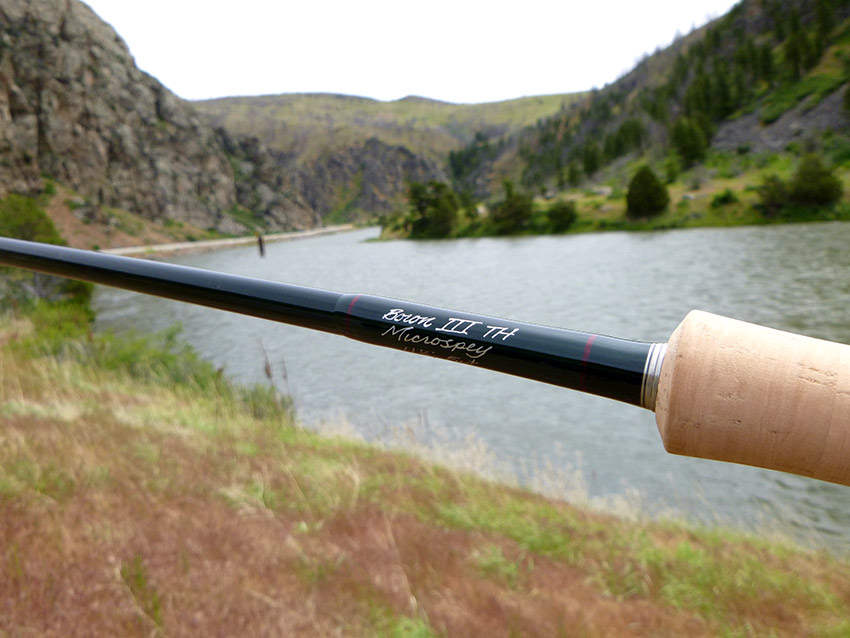

For those who appreciate a softer action, the R.L. Winston Micro Spey 11’6” 5-weight rod oozes soul and is overflowing with feel. It is definitely not the most powerful rod in the test, and struggled when casting directly into the wind or when trying to throw long. Of all the rods tested, the Micro Spey is the lightest rod in terms of overall weight. And one of the top three lightest in terms of swing weight, (behind the Beulah Platinum and T&T DNA). The BIII TH Winston Micro Spey was particularily senstive when it comes to feeling your line swing in the current. As always, I was impressed with Winston’s attention to detail and dedication to impeccable craftsmanship.
For anglers who are looking to be as smooth as possible while swinging their line, this softer and sensitive rod is a great choice.
Like all Winston rods, the Micro Spey blanks are finished in a beautiful emerald green with matching green wraps over TiCH finished stripper guides and chrome snake guides. Winston hand writes the serial number on each section, which is handy to know which section goes with which rod, (should you own other Winston TH micro spey rods). The serial numbers also act as alignment dots for quick and easy assembly. The anodized aluminum down-lock reel seat looks sharp and the two lock rings function well. The cork is excellent quality. The foregrip is perfect but the rear-grip is a bit on the small side. A classy aluminum rod tube and cloth bag are included.
Casting Notes:
Similar in feel to the Beulah Platinum, the Winston TH Micro Spey is the softest rod in the Shootout. Plenty of zen like feel, but it lacks the power of the Sage ONE, G. Loomis IMX PRO, and T&T DNA. The Winston Microspey felt awesome and fun to cast unless I had to cast into a hard wind. Still, a great rod for anyone who prefers a slower, softer action.
7. Beulah Platinum 11’7” 5-weight $595.00
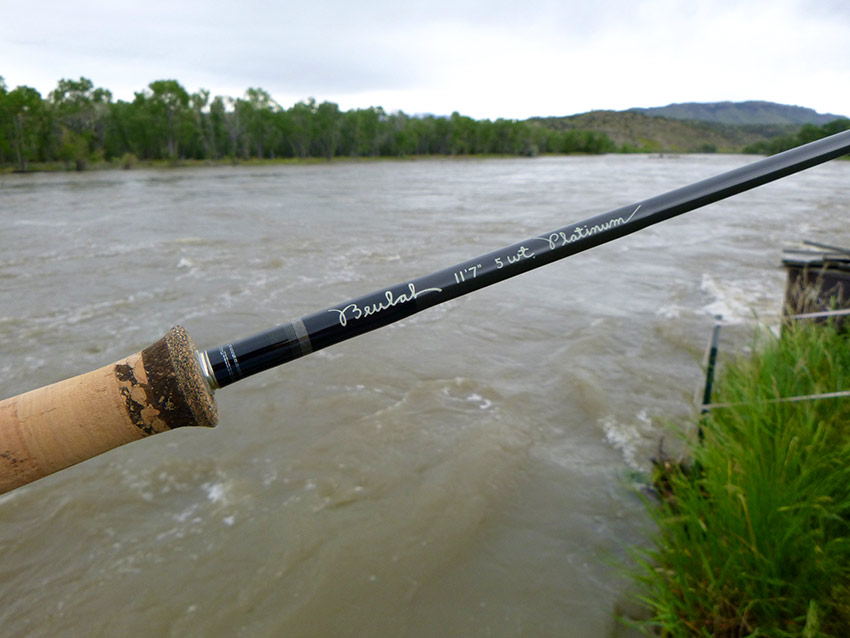

The Beulah Platinum had the lightest swing weight out of all the trout spey rods. At 11’7” it felt more like a 10’ rod in my hands. Anglers who prefer a softer action will really like this rod. As smooth as this rod felt, I wish it had a little more power for the Livingston wind. I also wish it was longer, since the 11’7″ length made it more difficult to mend and manipulate my line during the swing.
This is a wondeful rod for anglers who appreciate slower, softer actions. It would be a great rod for swinging soft hackles in a riffle.
The Beulah Platinum is finished in a graphite gray colored blank with olive wraps over ceramic lined stripper guides and chrome snake guides. The custom anodized aluminum reel seat isn’t nearly as fancy as the Onyx but functions well. The Cork is excellent quality and the shape of both the forgrip and rear grip are perfect for trout spey. A cordura covered rod tube and cloth bag are included.
When we originally tested this the Beulah Platinum 11’7″#5-weight it was $100 less at $495. Now the current and correct price is $595.00.
Casting Notes:
The Platinum’s smooth medium action makes casting fun, but it was more difficult for me to produce tight loops. You really have to wait for this rod and let it do the work rather try to punch it or force it to work. Although this rod is in between 11 and 12 feet and could really be used to nymph or swing, it is a better swing rod, mainly because it is too soft to effectively set the hook when the bobber goes down. One thing I loved about the Platinum was it’s light swing weight. It is the lightest of the Shootout. If you aren’t looking to cast too far, this might be the nicest, lightest rod in the test. If you are looking for more distance and a rod that will mend better, the Onyx a better is all-around swing rod.
8. TFO DeerCreek 12’6” 5/6-weight $469.95
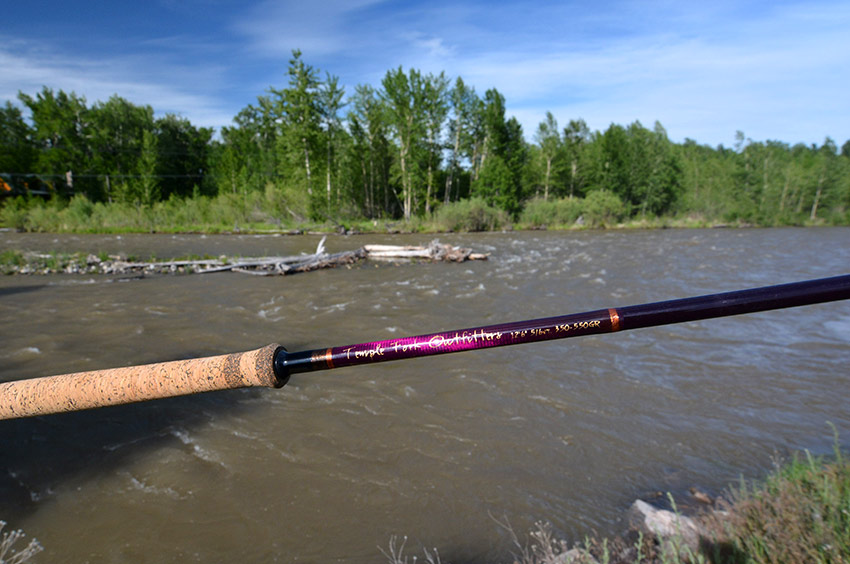

The TFO DeerCreek is a beast of a trout spey rod. While most of the rods here handle a 360 grain Skagit Scout, the DeerCreek casts much better with a 390 gain, and can handle heavier FLO tips like T-14 or even T-18. While this rod has great power, it feels much heavier when compared to other rods, and has the heaviest swing weight of all the rods tested. It also has the stiffest tip of any rod tested. Perhaps the reason for this extra weight is that TFO uses both a layer of IM6 graphite as well as a layer of Kevlar woven into the blank in a crisscross patern. The good side to all this is the Deer Creek is a very durable rod and one that is unlikely to break.
While the 5 pc construction makes this rod slightly smaller and more packable than the 4 piece rods, it won’t break down “in half” like the other rods in the test. I prefer rods that fold in half, so I can reel my fly to the tip, take the rod apart at the mid point, and fold it in half for easy lunch hour fishing trips or for fishing after work.
This is a good rod for anglers trying to swing slow and deep with heavy sink tips.
The TFO DeerCreek rods are finished in a unique reddish/purple that really lights up in the sun. The matching purple wraps cover two large stripper guides and chrome snake guides. The black aluminum up-lock reel seat isn’t fancy with two locking rings that tend to squeak over time. The cork grip is different from other handles, using a conglomerate of worm cork rather than cork rings. The grip on this rod is significantly thinner than other rods, which could actually be a good thing for anglers with smaller hands. A cloth bag is included, but no hard rod tube.
When we first tested this rod the TFO DeerCreek 12’6″#5/6 was $424.95, which has since gone up $45.00 to $469.95.
Casting Notes:
This rod is downright heavy. Not nearly as smooth as the other rods although admittedly a lot of power. Once I switched to the 390 grain this rod felt much better and less “choppy.” It is definitely more on the 6-weight side rather than a 5-weight trout spey. If you are looking to throw larger streamers this may be a good option, however the Orvis Clearwater is lighter with equal power and costs less.

James Anderson with a Yellowstone brown caught by high sticking a switch rod.

Trout Switch Rods – For Nymph Fishing
l. Orivs Helios 2 Switch 11’ 5-weight $885.00 – Discontinued


Good news / bad news here. The Good news is the Orvis H2 switch 11’ 5-weight is easily my favorite trout switch rod for nymph fishing (out of the boat or on foot). The bad news is that it has been discontinued already! And that really is bad news as there are not many of these available on eBay or Craig’s List. If you happen to own one of these, consider yourself lucky!
The 11’ foot length allows you to easily “high stick” over faster currents and enables you to make better mends in order to achieve that perfect dead drift than a 10 foot rod. The beauty of the H2 switch 11’ 5-weight is that it feels so incredibly light yet has tons of power for setting the hook or casting a heavy indicator set up. Orvis claims the H2 line is 20 percent stronger and 20 percent lighter than their previous Helios rods.
Like the Orvis Helios 2 single hand rods, the H2 11’5-weight switch rod has a beautiful smoke blue colored blank with silver trim thread wraps and high-end flexible titanium snake guides. The classy up-lock reel seat utilizes a black and blue carbon fiber style inlay with two solid lock rings to secure your reel tightly. The cork shape and quality are both excellent. A hard case tube and cloth bag are included.
Orvis is not working on any Helios 3 two-handed rods to replace the H2, however Orvis tells us they are currently working on a new USA made two-handed Clearwater rod series. These new rods will be launched at IFTD 2018 and will be ready to ship in October of 2018.
Casting Notes:
Absolute line ripper. Light, fast, powerful, amazing. Casts well in close, cast well at distance. Plenty of butt section power for fast and deliberate hook sets. Casting single hand style this rod felt better than everything and easily throws the tightest loops of all the trout switch rods here.
2. Douglas DXF 10’6” 5-weight $425.00


Your new trout switch winner by default – The Douglas DXF! The DXF series has been a favorite of ours since we first tested it in our 2015 9’ 5-weight shootout. We were happy to see that the trend of excellent design, terrific performance, and a reasonable price continues with the 10’6” 5-weight switch rod. The DXF looks and performs like a rod that should cost twice as much as it does.
At only 7.3 ounces, the DXF has the second lightest swing weight in the test, following the Orvis Helios 2. You can easily high stick this rod all day without over tiring your arm, enabling you to get incredibly long and perfect drifts out of the drift boat. It is also feels light and easy to cast, even with a heavy indicator rig.
The DXF blanks are finished in a tasteful matte forest green color with matching dark green wraps over hard chrome stripper and snake guides. Easy assembly alignment dots are used. The anodized aluminum up-lock reel seat isn’t too fancy but the two lock rings secure the reel adequately. The cork handle has a nice shape and the quality of the cork is very good. A Cordura cover hard case and cloth bag are included.
Now that the Orvis H2 switch rod has been discontinued, this is the nicest trout switch rod we’ve found on the market, and at $425 it’s a great bargain!
Casting Notes:
Very light in the hand, only the Orvis H2 felt lighter. Fast action but a tad bit slower than the H2. Significantly faster faster action than the St. Croix Imperial, Beulah Platinum, and Redington Dually. Good recovery and plenty of power to set the hook. Reel seat, cork and components are nice enough but not in the same ball park as the Orivs H2, Winston Micro Spey, T&T DNA, or Custom Flywerks.
3. Fenwick Aetos 11’1” 5/6-weight $299.95
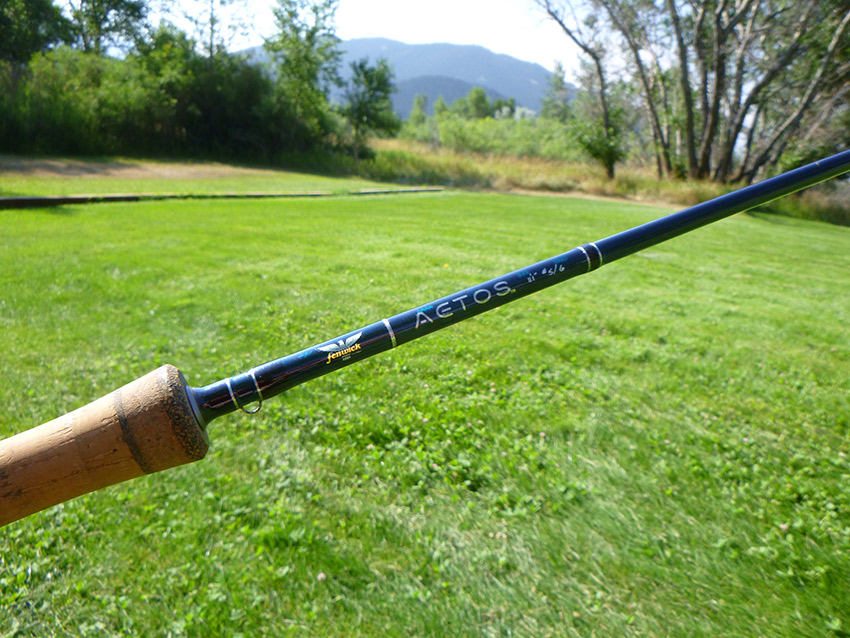

Following suit with Fenwick’s single hand Aetos rods, the 11’1” 5/6-weight trout switch rods have a fast action and are capable of producing powerful casts with tight loops. The Aetos series has always been one of our favorites when considering high performance at a low cost, and the 11’1” 5/6-weight is no different.
The Aetos blanks are finished in a dark teal blue color with black wraps over gunsmoke stripper and snake guides. Alignment dots are used for quick and easy assembly and each section also has the model size and weight on it (should you have more than one Aetos switch rod for easy identification). The Aluminum anodized up-lock reel seat is not elaborate but functions well. The cork handle shape and quality are both excellent for an inexpensive rod. A four-way split Corudra covered rod tube is included but no cloth bag.
The Aetos is our pick for the best inexpensive trout switch rod.
We did some checking on the latest Fenwick warranty policy, and found that they have one of the best warranties we have found. This is a lifetime warranty, and if this rod breaks, they They will repair (but usually replace the rod) for $35. Turnaround time is usually two weeks.
Casting Notes:
Heavier than the Orvis H2 but similar in terms of a fast action rod with lots of power. Produces nice tight loops and is good even when fishing into the wind. One of the best rods casting single hand style, despite a little more swing weight. Plenty of backbone to bury the hook when you see the indicator go down.
4. St. Croix Imperial 11’ 5-weight $300.00
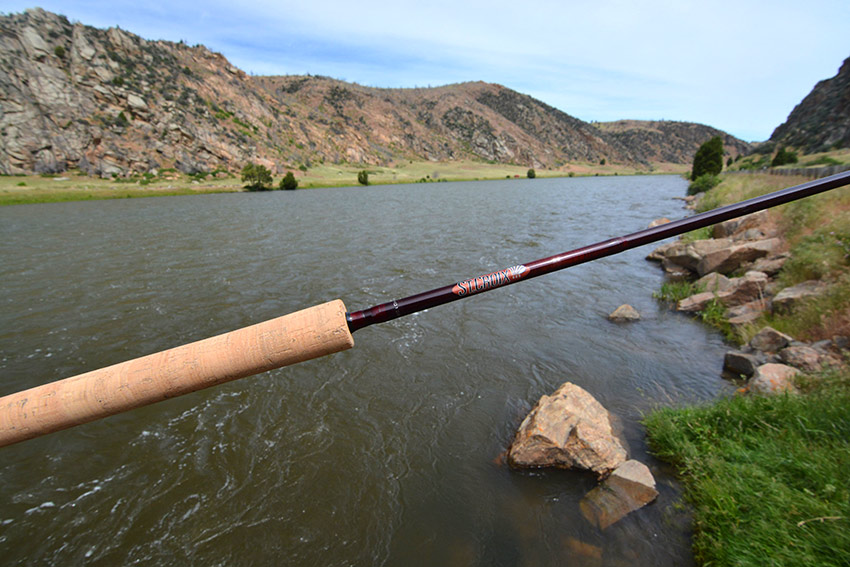

The St. Croix Imperial 11’ 5-weight is another good choice for an angler looking for a great performing rod without the high-end price tag. The Imperial trout 5-weight switch rod has more of a medium action than a fast action, with a wide, easy-to-hit sweet spot. Really the only thing holding the Imperial back from an even better finish is its heavier swing weight. Perhaps one reason these rods feel heavier, is because St. Croix double coats the mid-modulus blanks with flex coat to make them more durable.
The Imperial blanks are finished with a deep garnet red with matching red thread wraps over Aluminum-oxide stripper guides and hard chrome snake guides. The up-lock aluminum reel seat isn’t elegant, however we do like the functionality of the two locking rings, which twist well on wide threads, (unlike thinner threads, that can collect sand and debris). The cork quality is decent, but there is no swell at the top of the cork handle, which looks a little odd. The grip is also thicker than most, while the tiptop is a little bit smaller than we like.
If you are looking for an affordable, medium-fast 5-weight trout switch rod, the St. Croix Imperial is a great choice.
Casting Notes:
Heavier in hand compared to the H2 and DXF, but still exceptionally smooth. Wide, easy to hit casting sweet spot. Very forgiving. The medium action makes this rod fun to cast however I had more difficulty getting super tight loops. The Imperial is a fun rod to cast at a great price.
5. Echo Classic 10’9” 5-weight $239.95 – Discontinued
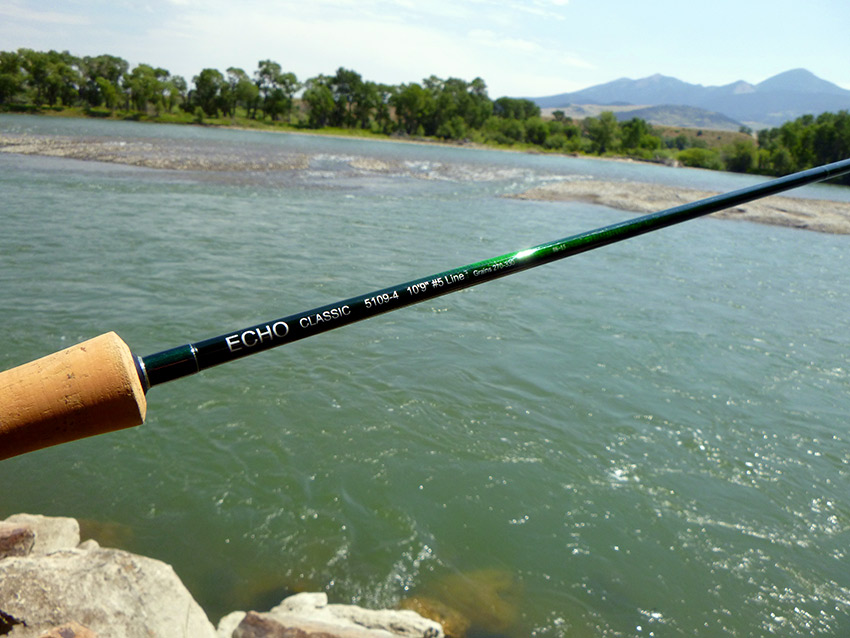

The least expensive of all the rods tested, the Echo Classic is a bargain for someone interested in learning how to use a two handed rod. Unfortunately, this rod is now discontinued. If you can find one on eBay it is similar to the St. Croix Imperial, the Echo Classic 10’9” 5-weight has a very smooth, forgiving feel to it. Like the Imperial, the Echo classic is a medium-fast action. The main thing holding the Echo Classic back from a higher finish is its heavy swing weight.
The Echo Classic blanks are finished in a deep green color with matching dark green wraps over chrome snake guides with silver trim. Alignment dots are used for easy assembly. The cork handle is satisfactory in both shape and quality. A Cordura covered rod tube and cloth bag are included.
Casting Notes:
Great feel and smooth power. Nice, wide, easy-to-hit sweet spot makes this rod very forgiving. This rod just feels too heavy. In hand it feels significantly heavier than the Orvis H2, Douglas DXF, Fenwick Aetos, and St. Croix Imperial.
6. Hardy Jet 10’6” 5/6-weight $294.50
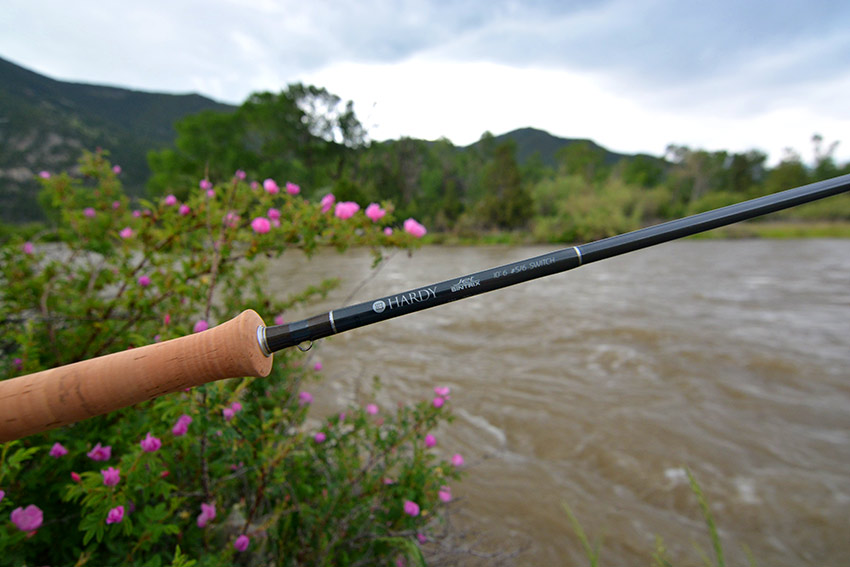

For only being 10’6” I thought this rod would feel a lot lighter, especially since the Hardy Zenith regular spey rods feel so light in hand. The H2 was significantly lighter, faster, and more powerful. The Jet’s medium-fast action is fun but this rod definitely needs more power when casting into the wind. It’s lack of butt and mid-section power makes it more difficult to set the hook, compared to the Orvis H2 or Douglas DXF. I think a Rio Switch 4/5 line would be better on this rod than the 5/6 we originally tested it with.
The Hardy Jet #5/6 switch rod is finished in a grey graphite color with matching dark grey wraps over fuji stripper and snake guides. The down-lock aluminum reel seat isn’t fancy but functions well with two locking rings. The cork quality is excellent although the rear handle grip is a little short. A cordura covered rod tube and a cloth bag are both included.
When we originally tested this rod it was $589, now the price has dropped in half and costs only $294.50, making this rod a bargain, while supplies last.
Casting Notes:
This rod feels heavy compared to the rest of the switch rods. This seems strange to me since it is not very stiff. Moving down to a lighter 4/5 switch line will make it perform better.
7. Redington Dually 11’5” 5-weight $249.95


The Redington Dually 11’5” 5-weight is another inexpensive rod coming in under $300.00. Similar to the Echo Classic and St. Croix Imperial, the Dually is more of a medium-fast rod with a wide sweet spot.
In the inexpensive category, we like the shorter Fenwick Aetos 11’1” better for nymph fishing purposes, as it is faster and has a lighter swing weight. It also has more power for setting the hook. For $50 more clams I think the Aetos is a better buy.
The Dually blanks are finished in a deep matte burgundy color with matching thread wraps over chrome stripper and snake guides. Alignment dots are used for easy rod assembly. A simple cork with aluminum up-lock reel seat is utilized with two locking rings. The cork quality is decent and about what you’d expect for a less expensive rod. A cordura covered tube and cloth bag are included.
Casting Notes:
This rod feels much heavier than most of the other rods, despite its average length. More of a medium-fast action, this rod has a nice wide sweet spot which will be good for beginners. But the down side is that it may be more difficult to set the hook quickly and solidly compared to the Orvis H2, Douglas DXF, or Fenwick Aetos.
8. Fenwick Worldclass 11’6” 5/6-weight $469.85
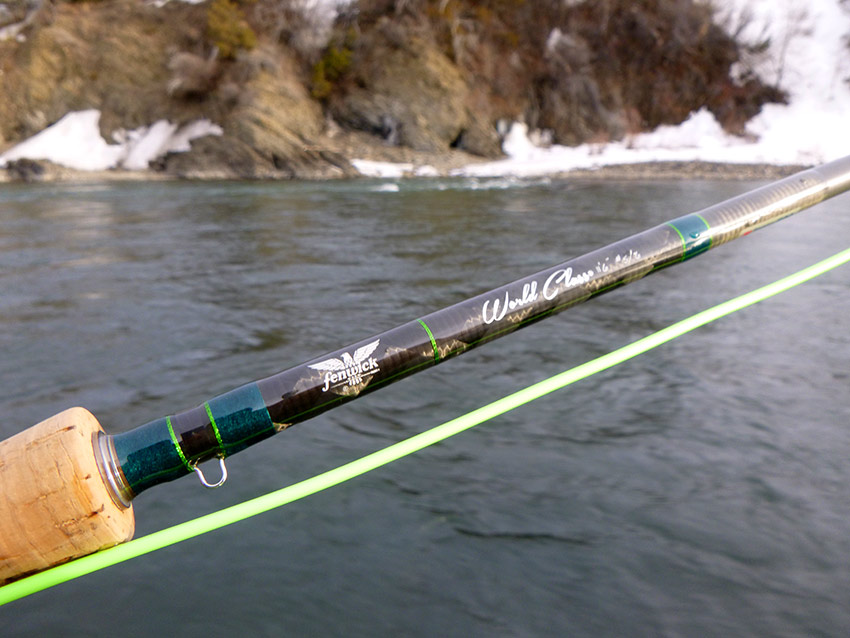

I liked this rod’s fast action, although it is just a little long for nymph fishing and a little too short for swinging. I was impressed with how light the World Class is. It is the third lightest rod in the test overall as well as the third lightest in terms of swing weight.
The only Achilles heel with this rod is the breakage factor (which may have something to do with it’s impressive light weight and swing weight). I actually broke this rod (middle of the third section) just casting it on the lawn with a switch line. For this reason alone we recommend you get a Fenwick Aetos 11’1”#5/6 instead, as they are significantly stronger, not to mention less expensive, ($170 less than the World Class 11’6” #5/6).
The Fenwick World Class blanks are finished in a grey graphite color with teal blue wraps over chrome stripper and snake guides. The cork quality isn’t the best and has a lot of filler for a $400 plus dollar rod, but the shape of the handle is nice. The aluminum down-lock reel seat isn’t fancy but works well.
Casting Notes:
This rod is light and crisp, but knowing the breakage issues, I would rather own a Fenwick Aetos for sure, which is 11’1” and a fraction of the price at $299.95.
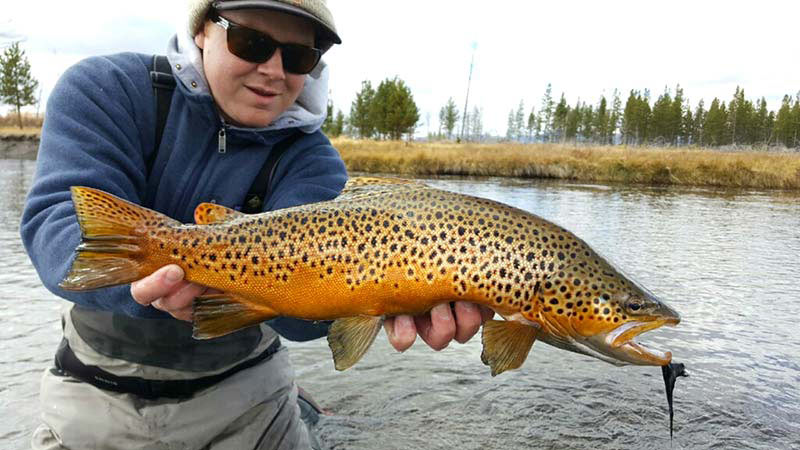
Logan Brown with a nice brown caught on the swing… Photo: The Axeman
Below you will see our picks for the best performing trout switch and trout spey outfits, each matched perfectly with the lines and reels we feel work best for a particular price point. Choose between three different budget levels: the best high-end outfit, the best mid-priced outfit, and the best economical outfit.
If you are the type of person that loves great gear and can afford to purchase the best, then by all means go for it! These high-end rods are simply delightful to cast and look fantastic. The reels we have selected will last you a lifetime of hard fishing, (and can also be used for saltwater fishing on your next tarpon trip). There’s a lot of truth in the saying, “buy nice or buy twice!”
Will the less expensive outfits also work well? They will indeed, but it’s nice to treat yourself every now and then. Life is short, what else are you going to spend it on? Let’s admit it, it feels great to love the rod and reel you are fishing with. Sometimes a little retail therapy can go a long way!
If you are looking for a trout switch or spey outfit that performs nearly as well as the best, without the high-end price tag, then the mid-priced outfits are a great way to go.
Is the best high-end outfit really $950 better than the best economical outfit? Ultimately each of us have to answer that question on our own, but the answer for most of us is going to be no. The important thing is getting out there and enjoying your time spent on the water period. The best economical outfits allow you to do just that and are not meant for just beginners. Inexpensive rods also make for good backups. Even if you do buy a nicer rod in the future, you’ll have a back up rod which you can to lend to a friend or use should your main rod be at the rod repair center.
Best High End Trout Spey Outfit
The “Ultimate” Trout Spey set up:
Sage ONE Trout Spey 12’6”#5 with an Einarsson Invictus 8/10

____________________
sub total: $2,338.87
<less line, FLO tip kit, backing & leader> <$238.87>
Includes free FLO tip zippered tip wallet –
Free ready to fish rigging –
No Tax –
Free Shipping –
____________________
Grand Total: $2,100.00
If you plan to swing for trout, the Sage ONE 12’6”#5 is the sweetest rod you can find at any price. This is the perfect length for spey casts, insanely light for mending and high sticking your swing, and can seriously launch a fly. If you are a steelheader looking to keep your cast in tip top shape while you are not pursing steelhead, this rod is going to feel and act like your 7 or 8 weight spey rod yet feel much lighter and more fun while fishing for fish under 30 inches.
I really enjoyed fishing this rod in every condition that came up. If it was calm, I could take my time and really let the rod do the work, making casting both smooth and easy. If the wind picked up, (as it usually does in Livingston on the Yellowstone), I could cast more aggressively with the ONE and “punch” a long bomb out there further than other rods. The other two trout spey rods that seemed to handle the wind well were the 11’11” G. Loomis IMX Pro and the 11’9” Thomas and Thomas DNA.
What impressed me the most about the Sage ONE 12’6”#5 trout spey was its length and power to weight ratio. As the second longest rod in review, is still felt lively and light in your hand. Is it worth paying $700 to have such a light and powerful rod? If you can afford it then yes, of course. If buying a rod in this price category just isn’t in the cards for you (and for most of us it won’t be) I feel it is more important to pick up a less expensive rod and start learning. You can always trade up later if you really enjoy swinging for trout.
Our pick for the ultimate trout spey reel to match up with the ultimate trout spey rod has to be the new Einarsson Invictus 8/10. Designed and made in Iceland, the Invictus truly is a high-end reel. Not only does it look and feel like a Bentley or Rolls Royce of reels, but it also has a technology that no other reel has – a spring loaded drag that increases hook up rates when swinging a fly.
Not only does it look fantastic, this reel has a spring in it which is designed to smooth out the take of the fly and help increase hookups. This is especially important when swinging for Atlantic Salmon or steelhead when you may only see one hook up a week, but it is also nice when fishing for big browns and rainbows too. While there are many reels with great drag stytems, we can’t think of any other reels that actually help you hook up and stay hooked up. For this reason alone, we love the Invictus, but we also love the quality build, sound, and over quality that this reel possesses. Finding a nicer reel will be difficult. The bad news is the price tag that is over $1000.00. If you would like to substitute a good but less expensive reel like the Einarsson 9 Plus at $732.00 or even the TFO 375 at $374.95, give us a call.
The Airflow Scout 360 skagit line works perfectly with the Sage ONE 12’6”#5 trout spey. It loads the rod well, making your spey, double spey, snap T, snap Z, and D-loop smooth yet powerful.
We also love the Airflow Skagit FLO tips. These tips have a thicker diameter and more mass than other tips, which translates to a smoother transition between your line and leader. This smoother transition matches the thickness of the Skagit line as well as the leader on the other end, making this the best tip we have found. The result is awesome turnover, with an even tighter loop, which is better when punching into the wind and also for accuracy (if needed).
With the Ultimate Trout Spey set up, we decided anglers willing to go this far will want the entire Airflow FLO tip “kit” which includes 5 tips raning from the lightest T7, all the way up to T-18. This will allow you to choose the best tip for the speed, depth, and temperature of the water you are fishing.
As far as running line goes, everyone has their own preferences and we can adjust to this when you order an outfit. Our standard is to use Scientific Anglers floating braided PE mono, which has a very slick coating and shoots well, yet does not have the memory issues of mono. Also it is easier to grip than mono, which works well when stripping your fly to add action or while winter fishing, once your hands are cold.
The Invictus has a lot of room for backing capacity – you’ll get about 200 yards of 20 pound backing. This is plenty of dacron backing, that won’t cut you like gel spun.
Last but not least we have a short but effective leader designed for excellent turnover and stealth. When fishing a sink tip a longer leader defeats the purpose of a sink tip. Too short, and the fish may see the black tungsten coated line on your FLO tip.
This combination is incredible. With it you’ll feel like you have the best chance at swinging up a trout, and as we all know swinging up trout (or steelhead / salmon) requires confidence. In order to swing up a fish, you must believe it will happen. If any outfit is going to make it happen this is it.
Best Mid-Priced Trout Spey Outfit:
G. Loomis IMX Pro 11’11”#5 with TFO 375 reel
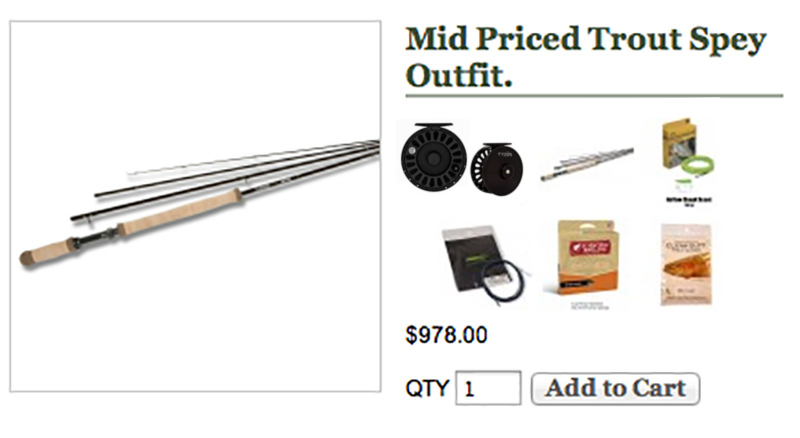
____________________
sub total: $1,085.82
<less free line, FLO tip, backing & leader
plus PE running line at cost> <$116.92>
Free ready to fish rigging –
No Tax –
Shipping $9.10
____________________
Grand Total: $978.00
If you’re looking for the high end feel and performance of our ultimate trout spey set up, but don’t want to spend nearly as much as you might spend on a used Honda Accord, take a look at our best mid-priced outfit.
Tag team designed by Tom Larimer and Steve Rajeff, the G. Loomis IMX pro is a terrific all-around swing weapon. In the hands of the most seasoned two-hander or in the hands of a total beginner, the IMX is light, powerful, and fun to fish.
All of the IMX Pro two-handers are a unique length of 11 feet 11 inches. Why not 12 feet? We’re not sure, but the end result is a rod that performs extremely well while swinging, yet can still be used aggressively as a switch rod out of the boat.
The length of this rod enables effortless, long casts but what really impresses me about the IMX Pro is it’s powerful butt section. Not only does this work well for saving a cast here and there should you get your timing wrong, but it also allows you to punch into the wind better than other rods – something we have to deal with nearly everyday here on the Yellowstone. I also like the stiffness in the butt section for setting the hook if you are happen to be fishing a streamer or nymph under the bobber. For me the 11’11”#5 is the perfect blend between stiffness and lightness, but if you prefer a softer more full flexing trout spey rod, be sure to check out the #4-weight, which is amazingly smooth and even more effortless to cast.
If you think you might be fishing rivers like the Missouri or Bighorn more often then you should highly consider the 11’11”#4. For rivers like the Yellowstone, Madison, or Bighole the #5 will be better for throwing larger flies, handling the wind, and casting longer distances.
We matched the IMX Pro up with one of our favorite trout switch and spey reels, the TFO 375. We love this reel because it is extremely durable, relatively inexpensive, has a great drag, and it spins with the best of them. All you have to do is flick the reel handle quickly and let the 375’s smooth bearings do the work. You can also “slap” the face of your reel to accomplish the same fast spin which will bring your running line in at a rapid pace. This can be handy not only when reeling in, but if you don’t cast as far as you think you were going to, you can spin your slack up quickly and swing it through with your line tight to the reel before re-casting. If you like to strip your running line, as we often do while fishing for big browns, and get a hook up with 10-20 feet of running line out, very few reels can capture line as quickly as the TFO 375, enabling you to keep your eye on the fish and reel up your slack almost instantly.
The TFO 375 and TFO425 both utilize a carbon fiber drag system that compresses into the spool when tightened down. The drag is smooth and reliable. I personally own a couple 425’s that are now nearly 10 years old and they work just as well as they did a decade ago. They have taken on some nicks and dings, but overall have proven to be extremely tough, even through some of the worst rip-rap falls.
The TFO 375 comes in black, red, gold, or charcoal grey however most of our stock is now black. It will be difficult to find red or gold as these reels are now discontinued. We also have a few larger TFO 425’s in stock which are perfect for 8-11 weight spey rods, and also double as a solid tarpon reel should you make your way to the salt.
The Airflow Scout 360 skagit line is the perfect match with the 11’11”#5 G. Loomis IMX Pro. It feels like this line was designed to be used on this rod, making it easy to learn spey casts with. Experts will love this line as the 360 grain line perfectly loads the IMX Pro and will allow a good angler to achieve maximum distances with little to no effort.
We also love the Airflow Skagit FLO tips. These tips have a thicker diameter and more mass than other tips, which translates to a smoother transition between your line and leader. This smoother transition matches the thickness of the Skagit line as well as the leader on the other end, making this the best tip we have found. The result is awesome turnover, with an even tighter loop, which is better when punching into the wind and also for accuracy (if needed).
As far as running line goes, everyone has their own preferences and we can adjust to this when you order an outfit. Our standard is to use Scientific Anglers floating braided PE mono, which has a very slick coating and shoots well, yet does not have the memory issues of mono. Also it is easier to grip than mono, which works well when stripping your fly to add action or while winter fishing, once your hands are cold.
Last but not least we have a short but effective leader designed for excellent turnover and stealth. When fishing a sink tip, a longer leader defeats the purpose of a sink tip. Too short, and the fish may see the black tungsten coated line on your FLO tip.
Best Economical Trout Spey Outfit:
Orvis Clearwater 12’#5 with Orvis Battenkill IV

____________________
sub total: $595.82
<line, FLO tip, running line,
backing & leader at cost> <$55.82>
Free ready to fish rigging –
No Tax –
Free Shipping –
____________________
Grand Total: $540.00
Here is our pick for the best inexpensive rod and reel combo to swing with. The Clearwater is a powerful rod yet it has a wide, easy-to-load sweet spot and is a great rod to learn spey casts with. At 12 feet long, the Clearwater is long enough to make big mends and manipulate the line better than shorter trout spey rods, yet does not feel brutally heavy.
We matched this rod with an Orvis battenkill V reel, which is light, durable, and proven to last the test of time. We also like the click and pawl sound you get with the Orvis Bettenkill. You’ll have this reel for a long time, even if you decide to later upgrade to a newer, lighter rod. For the largest fish caught on the Battenkill, you may want to “palm” the rim of the spool, which will add extra resistance to the reel’s drag. In this respect you can make the drag as strong as you need manually, since the drag won’t turn up very strong on it’s own. That being said, it has enough resistance to keep the reel and line from free spooling and tangling, which is all you really need. There won’t be any need to yell out “fish on!” to your buddies since the sweet, classic sound of the Battenkill will do the talking for you!
The Airflow Scout 360 skagit line is the perfect match for the Orvis Clearwater 12’#5 in the hands of an experienced caster. We figured most people who are learning to spey cast would benefit from a slightly heavier line however, so we chose the 390 grain Skagit Scout. The extra grain weight will allow a learning spey caster to feel the line load better, and in the long run it will be a less frustrating line to learn with. If you are already an experienced caster we can easily switch the 390 out for a 360 grain.
We love the Airflow Skagit FLO tips. These tips have a thicker diameter and more mass than other tips, which translates to a smoother transition between your line and leader. This smoother transition matches the thickness of the Skagit line as well as the leader on the other end, making this the best tip we have found. The result is awesome turnover, with an even tighter loop, which is better when punching into the wind and also for accuracy (if needed).
As far as running line goes, we cut down costs by spinning your reel up with 50 yards of #30 pound Amnesia. This is the same material we use in the but sectoins of our Hot Butt leaders. It does have some memory to it, especially when it is cold outside so you’ll want to stretch this before each day’s use. It is easy to see and shoots great at a far less cost than other mono running lines. The best running line, the SA floating braided PE mono would only add another $30 and you can request this over the Amnesia.
Last but not least we have a short but effective leader designed for excellent turnover and stealth. When fishing a sink tip a longer leader defeats the purpose of a sink tip. Too short, and the fish may see the black tungsten coated line on your FLO tip.
Best Mid-Priced trout switch outfit:
Douglas DXF 10’6”#5 with a TFO 325 reel
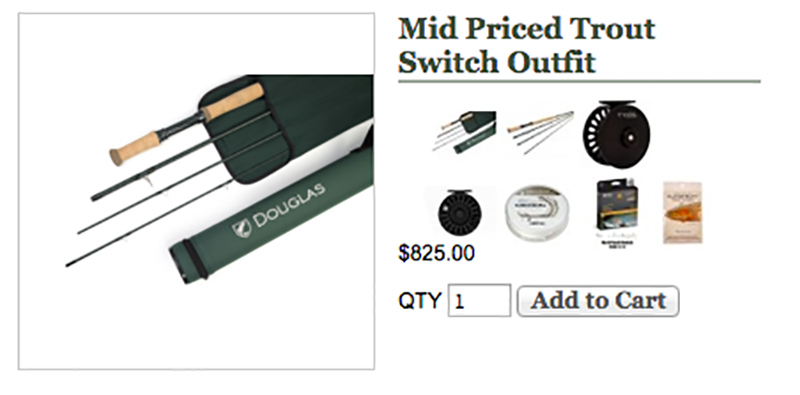
____________________
sub total: $915.80
<less free line> <$99.95>
Free ready to fish rigging –
No Tax –
Shipping $9.15
____________________
Grand Total: $825.00
The Douglas DXF series has long since been a favorite of our since we saw how well it performed in our 5-weight shootouts. It is our favorite mid-priced rod in the 9’#5, and also our pick for the best mid-priced trout switch rod. Now that the Orvis Helios 2 has been discontinued, we feel the DXF is not only the best mid-priced trout switch rod, but it is also the best performing trout switch rod on the market.
This rod is exceptionally light both in terms of overall weight and swing weight. Of all 17 two-handers we cast, only the Hardy Jet was lighter. With the DXF’s light yet powerful construction, this rod means business and brings a formidable game without an overbearing price tag.
The cork grip on the DXF is a nicer quality than other rods in its price range, and significantly nicer than less expensive trout switch rods. We like the matte green blank color and the matching green thread wraps over the snake foot style guides. While not overly fancy, the aluminum up-lock reel seat functions well.
We matched all of our mid-priced outfits with a Temple fork Outfitters 375. We love this reel because it is extremely burly and durable for the price, and also we love the way we can spin up this reel. Like spinning skateboard wheel and watching it go, this reel is second to none when it comes to flicking the handle or slapping the face of the reel and watching it spin while picking up your running line in a hurry. For the money, the 375 is one of our all time favorite switch and spey reels.
Again we went with the Rio intouch WF-5-F line as the perfect match. You’ll be able to turn over an indicator, even in harsh wind, and still be able to stack mend down the river.
No need for Hatch backing in this case, as the TFO 375 wide spool has plenty of backing capacity. Save your money and go with regular 20 pound dacron backing instead.
Last but not least, our own hand tied nymph leader tied with stiff butt sections for better turnover while utilizing a long knotless section of 20 pound, to allow for easy bobber adjustment.
Best Economical trout switch outfit:
Fenwick Aetos 11’#5 with an Orvis Battenkill IV reel
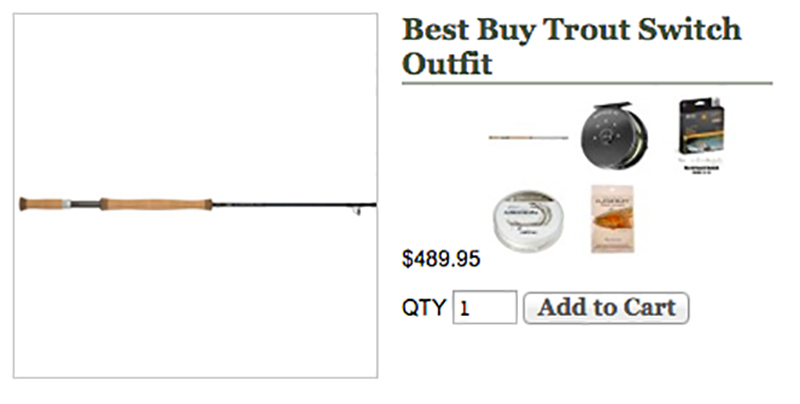
____________________
sub total: $555.75
line at cost, free backing, & leader <$65.81>
Free ready to fish rigging –
No Tax –
Free Shipping –
____________________
Grand Total: $489.95
It was hard to pick the best economical outfit because the St. Croix Imperial was also an excellent rod at about the same price.
The one thing we liked better about the Aetos was its lighter swing weight and feel. If you’re going to be high sticking out of the boat all day chasing a bobber, your arm is going to get fatigued. Lighter rods like the Aetos enable you to keep fishing hard all day long.
The Fenwick Aetos comes in a deep blue color that sparkles beautifully in the sun. The reel seat has nice threads that don’t collect sand or grit and get jammed. The Aetos has large snake style guides, which will assist in allowing tangles to escape through the tip when you have a fish peeling line off your reel.
We matched this rod with an Orvis battenkill V reel, which is light, durable, and proven to last the test of time. We also like the click and pawl sound you get with the Orvis Bettenkill. You’ll have this reel for a long time, even if you decide to later upgrade to a newer, lighter rod. For the largest fish caught on the Battenkill, you may want to “palm” the rim of the spool, which will add extra resistance to the reel’s drag. In this respect you can make the drag as strong as you need manually, since the drag won’t turn up very strong on it’s own. That being said, it has enough resistance to keep the reel and line from free spooling and tangling, which is all you really need. There won’t be any need to yell out “fish on!” to your buddies since the sweet, classic sound of the Battenkill will do the talking for you!
Last but not least, our own hand tied nymph leader tied with stiff butt sections for better turnover while utilizing a long knotless section of 20 pound to allow for easy indicator adjustment.
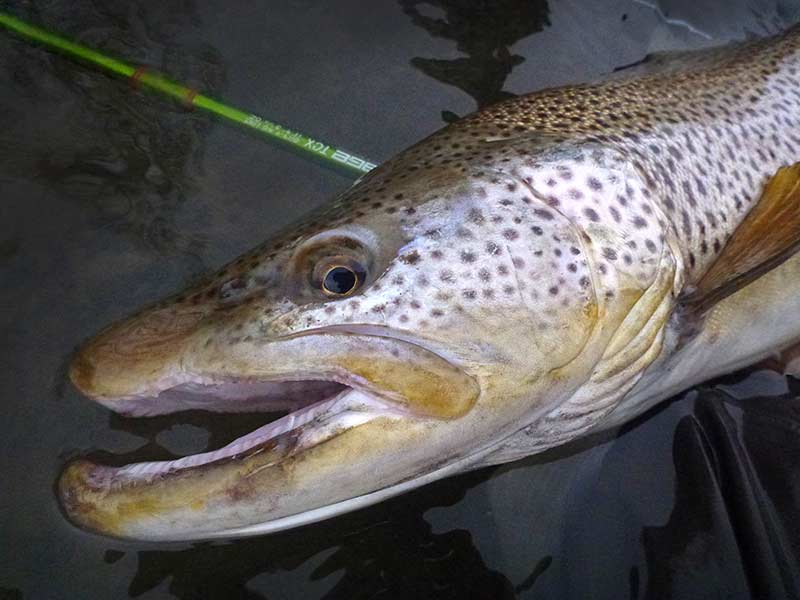
Targeting Larger Trout, Steelhead, or Salmon?
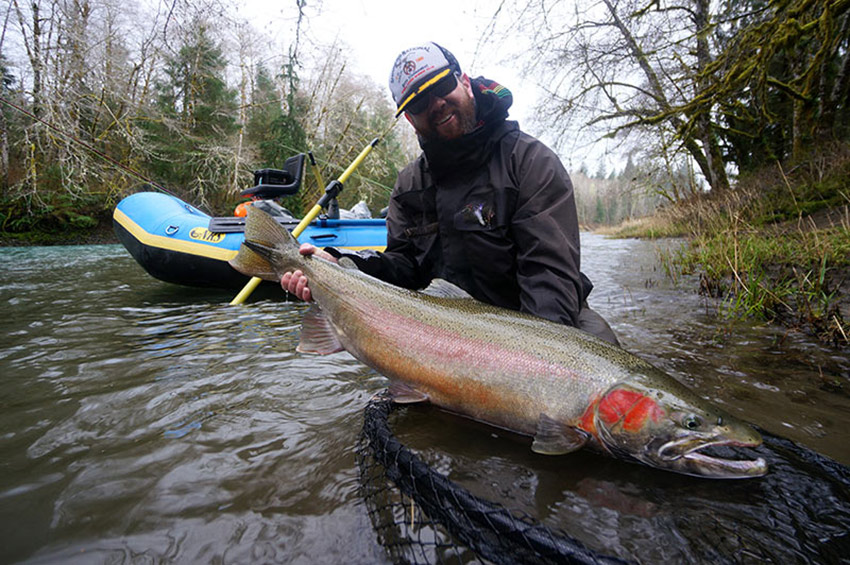
James Anderson with an OP steelhead. Photo: Eric Paulson
Give us a call at the shop anytime you want to talk rods regarding “regular” switch and spey rods. Personally on the Yellowstone, I prefer to fish larger spey rods most of the time over trout spey rods, since they offer more power on windy days and will throw larger flies when going for that hog brown trout. Give us a call anytime and we can help you determine which type of two-handed rod is right you. 1-406-222-7130.
We need your support!
We hope you have enjoyed reading our 2017 5-weight Trout Switch and Spey Rod Shootout. We always recommend you try to buy a rod (or outfit) from your own favorite fly shop. However, if your fly shop doesn’t carry the rod that interests you, we would love to help! With your support, we can continue to give you more Shootouts and head to head comparisons on tackle and fishing equipment in the future. But these Shootouts take us a lot of time, so if you are in the market for a new rod or outfit, and you found our Shootout helpful, please consider buying that new rod or outfit from us.
Be sure to e-mail us your comments and any questions you have about the exact tackle you need for the fishing you are doing or tackle needs for a trip you are planning.
– James Anderson and the rest of the Yellowstone Angler crew